1.Spring概述
1.1 Spring框架是什么
Spring是与2003年兴起的一个轻量级的Java开发框架,它是为了解决企业应用开发的复杂性而创建的。Spring的核心是控制反转(IOC)和面向切面编程(AOP)。Spring是可以在Java SE/EE中使用的轻量级开源框架。
Spring的主要作用就是为代码"解耦",降低代码间的耦合度。就是让对象和对象(模板和模板)之间关系不是使用代码关联,而是通过配置来说明。即在Spring中说明对象(模块)的关系。
Spring根据代码的功能特点,使用IOC降低业务对象之间耦合度。IOC使得主业务在相互调用过程中,不用再自己维护关系了,即不用再自己创建要使用的对象了,而是由Spring容器统一管理,自动"注入",注入即赋值。而AOP使得系统服务得到了最大复用,且不用再由及程序手工将系统及服务"混杂"到主业务逻辑中了,而是由Spring容器统一完成
1.2 Spring优点
1.2.1 轻量
Spring框架使用的jar都比较小,一般在1M以下或者几百kb。Spring核心功能所需的jar包总共在3M左右
Spring框架运行占用的资源少,运行效率高。不依赖其他jar包
1.2.2 针对接口编程,解耦合
Spring提供了IoC控制反转,由容器管理对象,对象的依赖关系。原来在程序代码中的对象创建方式,现在由容器完成。对象之间的依赖解耦合。
1.2.3 AOP编程的支持
通过Spring提供的AOP功能,方便进行面向切面的编程,许多不容易用传统OOP实现的功能可以通过AOP轻松应付。
1.2.4 方便集成各种优秀框架
Spring不排斥各种优秀的开源框架,相反Spring可以降低各种框架的使用难度,Spring提供了对各种优秀框架(如 Sruts,Hibernate,MyBatis)等的直接支持,简化框架的使用。
2 IoC控制反转
2.1 概念
IoC,Inversion of Control:控制反转,是一个理论,一个指导思想。指导开发人员如何使用对象,管理对象的。把对象的创建,属性赋值,对象的生命周期都交给代码之外的容器管理。
1.IoC分为控制和反转
控制:对象创建,属性赋值,对象生命周期管理
反转:把开发人员管理对象的权限转移给了代码之外的容器实现。由容器完成对象的管理。
正转:开发人员在代码中,使用new构造方法创建对象。开发人员掌握了对象的创建,属性赋值,对象从开始到销毁的全部过程。开发人员有对 对象的全部控制。
通过容器,可以使用容器中的对象(容器已经创建了对象,对象属性赋值了,对象也组装好了)
2.IoC技术的实现
DI(依赖注入):Dependency Injection,缩写是DI。是IoC的一种技术实现。程序只需要提供要使用的对象的名称就可以了。对象如何创建,如何从容器中查找,获取都是由容器内部自己实现。
依赖名词:比如说ClassA类使用了ClassB的属性或者方法,叫做ClassA依赖ClassB
publicclassClassB{publicvoidcreateOrder(){}}publicclassClassA{//属性privateClassB b =newClassB();publicvoidbuy(){
b.createOrder();}}
执行ClassA的buy()ClassA a =newClassA();
a.buy();
3.Spring框架使用的DI实现IoC
通过Spring框架,只需要提供要使用的对象名词就可以了。从容器中获取名称对应的对象
Spring底层使用的 反射机制,通过反射创建对象,给属性赋值。
2.2 第一个spring项目
我们来创建第一个Spring项目
1.创建一个空项目
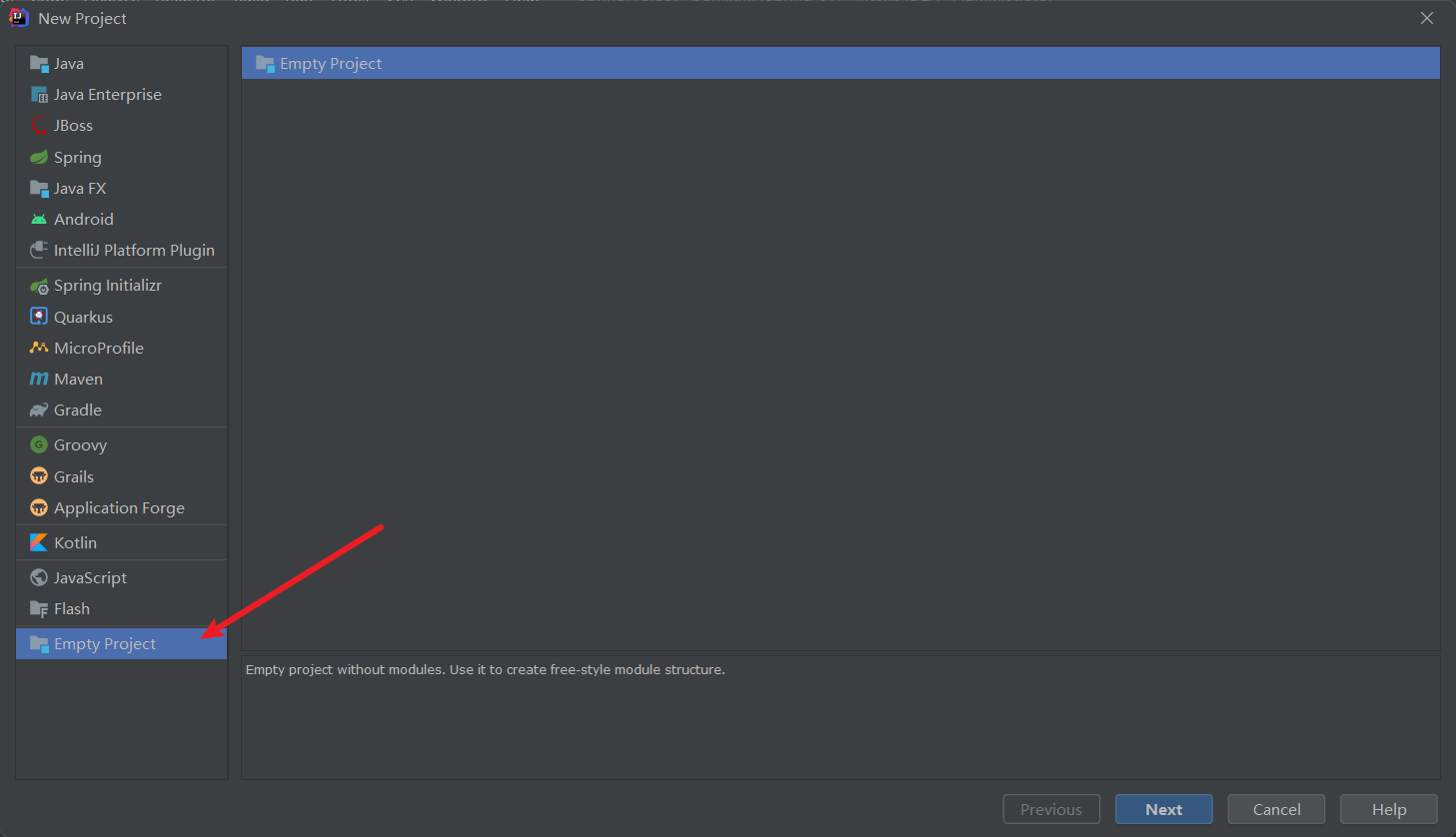
2.添加新的Module
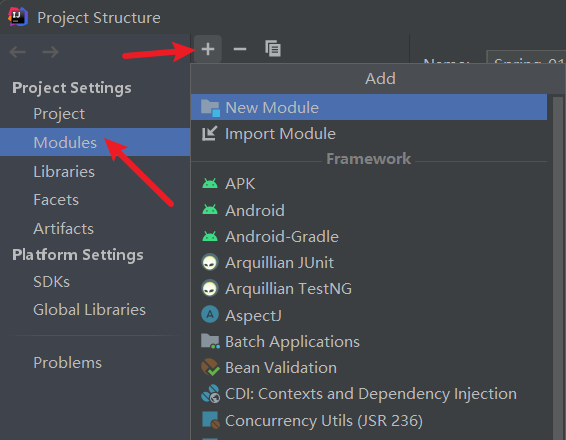
我们创建第一个项目,名称为Spring-01,创建完成后,我们来看项目目录结构
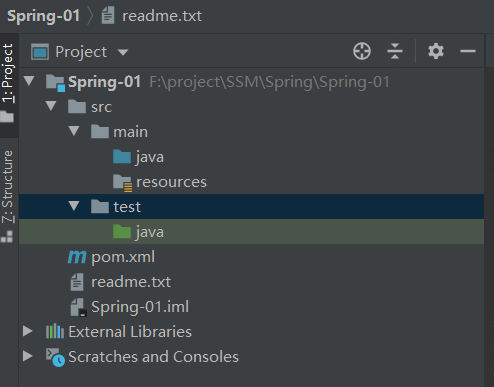
3.加入依赖,修改pom.xml
spring-context:spring依赖
junit:单元测试
<dependencies><dependency><groupId>junit</groupId><artifactId>junit</artifactId><version>4.13.2</version><scope>test</scope></dependency><!--spring依赖--><dependency><groupId>org.springframework</groupId><artifactId>spring-context</artifactId><version>5.3.4</version></dependency></dependencies>
4.开发人员定义类:接口和实现类
类也可以没有接口。
接口和实现类定义:和没有spring一样
接口的定义:
publicinterfaceSomeService{voiddoSome();}
实现类的定义:
importcom.lu.service.SomeService;publicclassSomeServiceImplimplementsSomeService{@OverridepublicvoiddoSome(){System.out.println("执行了业务方法doSome()...");}}
5.创建spring的配置文件
作用:声明对象
把对象交给spring创建和管理
使用表示对象生命,一个bean表示一个java对象
<?xml version="1.0" encoding="UTF-8"?><beansxmlns="http://www.springframework.org/schema/beans"xmlns:xsi="http://www.w3.org/2001/XMLSchema-instance"xsi:schemaLocation="http://www.springframework.org/schema/beans http://www.springframework.org/schema/beans/spring-beans.xsd"></beans>
spring标准的配置文件:
1.根标签是 beans
2.beans后面的是约束文件说明
3.beans里面是bean生命
4.什么是bean:bean就是java对象,spring容器管理的java对象,叫做bean
我们来创建一个对象
<?xml version="1.0" encoding="UTF-8"?><beansxmlns="http://www.springframework.org/schema/beans"xmlns:xsi="http://www.w3.org/2001/XMLSchema-instance"xsi:schemaLocation="http://www.springframework.org/schema/beans http://www.springframework.org/schema/beans/spring-beans.xsd"><!--声明对象
id:自定义对象名称,唯一值(可以没有,spring可以提供默认名称)
class:类的全限定名称,spring通过反射机制创建对象,不能是接口
spring根据id,class创建对象,把对象放入到spring的一个map对象。
map.put(id,对象)
--><beanid="someService"class="com.lu.service.impl.SomeServiceImpl"></bean></beans>
6.使用容器中的对象
创建一个表示spring容器的对象 AppplicationContext
从容器中,根据名称获取对象,使用getBean(“对象名称”)
packagecom.lu;importcom.lu.service.SomeService;importorg.junit.Test;importorg.springframework.context.ApplicationContext;importorg.springframework.context.support.ClassPathXmlApplicationContext;publicclassMyTest{@TestpublicvoidtestdoSomething(){//SomeService service = new SomeServiceImpl();//service.doSome();//1.指定spring配置文件:从类路径(classpath)之下开始的路径String config="beans.xml";//2.创建容器对象 ApplicationContext 表示spring容器对象。通过ctx获取某个java对象ApplicationContext ctx =newClassPathXmlApplicationContext(config);//3.从容器中获取指定名称的对象,使用getBean("id")SomeService service =(SomeService)ctx.getBean("someService");//4.调用对象的方法
service.doSome();}}
我们来运行一下:

成功运行!
2.3 三个问题的探究
1.我们来思考一个问题,通过spring来创建对象,是调用的类的无参构造函数吗?
我们来测试一下,我们现在实现类中定义一个无参构造方法
packagecom.lu.service.impl;importcom.lu.service.SomeService;publicclassSomeServiceImplimplementsSomeService{publicSomeServiceImpl(){System.out.println("无参构造");}@OverridepublicvoiddoSome(){System.out.println("执行了业务方法doSome()...");}}
然后在测试类中测试
//spring创建对象,调用的是类的哪个方法?@Testpublicvoidtest01(){String config ="beans.xml";ApplicationContext ctx =newClassPathXmlApplicationContext(config);//SomeService service = ctx.getBean(SomeService.class);//service.doSome();SomeService service =(SomeService) ctx.getBean("someService");
service.doSome();}
控制台输出:
看来真的是调用了无参构造方法,也就是说spring默认调用的是无参构造方法,也就是说我们在类中有有参构造方法的话,我们必须显示的声明无参构造方法
2.我们再来思考一个问题,spring是在什么时候创建的对象?
我们来写代码测试一下
//spring是在什么时候创建的对象?@Testpublicvoidtest02(){String config ="beans.xml";ApplicationContext ctx =newClassPathXmlApplicationContext(config);//SomeService service = (SomeService) ctx.getBean("someService");//service.doSome();}
我们把后面两行注释掉,跑一下代码

出来无参构造了,说明对象创建了,也就是说创建spring容器对象的时候,会读取配置文件,创建文件中声明的Java对象
这样做的优点是:
获取对象的速度快,因为对象已经创建好了
缺点:
占用内存
3.我们再来思考第三个问题,spring容器创建对象,一次创建几个呢?
我们来修改一下beans.xml文件
<?xml version="1.0" encoding="UTF-8"?><beansxmlns="http://www.springframework.org/schema/beans"xmlns:xsi="http://www.w3.org/2001/XMLSchema-instance"xsi:schemaLocation="http://www.springframework.org/schema/beans http://www.springframework.org/schema/beans/spring-beans.xsd"><beanid="someService"class="com.lu.service.impl.SomeServiceImpl"></bean><beanid="someService"class="com.lu.service.impl.SomeServiceImpl"></bean></beans>
跑一下测试类
//spring容器创建对象,一次创建几个@Testpublicvoidtest03(){String config ="beans.xml";ApplicationContext ctx =newClassPathXmlApplicationContext(config);//SomeService service = (SomeService) ctx.getBean("someService");//service.doSome();}
输出一下
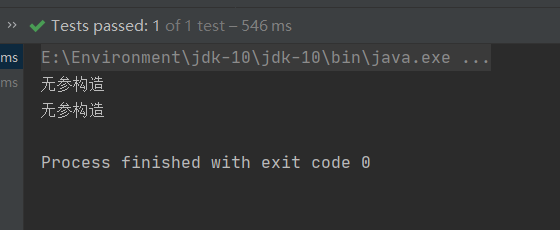
我们发现出来两个对象,也就是说:
在创建容器(ApplicationContext)对象时,会把配置文件中的所有对象都创建出来(spring的默认规则)
2.4 spring容器创建对象的特点
1.容器对象ApplicationContext:接口
通过ApplicationContext对象,获取要使用的其他Java对象,执行getBean(“的id”)
2.spring默认时调用类的无参构造方法,创建对象
3.spring读取配置文件,一次创建好所有的Java对象,都放到map中
2.4.1 获取容器中定义的对象信息
我们获取容器中定义的对象信息主要通过两个方法
getBeanDefinitionCount()//获取容器中定义对象的数量getBeanDefinitionNames()//获取容器中定义的对象名称
我们来编写测试类:
@Testpublicvoidtest04(){String config ="beans.xml";ApplicationContext ctx =newClassPathXmlApplicationContext(config);//获取容器中定义对象的数量int nums = ctx.getBeanDefinitionCount();System.out.println("容器中定义对象的数量=="+ nums);//获取容器中定义的对象名称String names[]= ctx.getBeanDefinitionNames();for(String name :
names){System.out.println("容器中对象的名称=="+ name);}}
控制台输出:
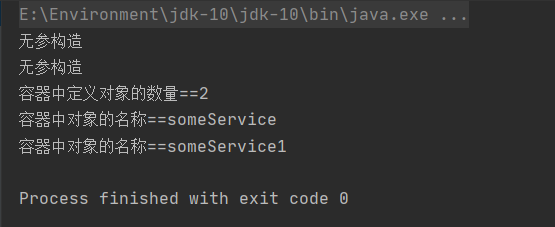
我们可以看到我们已经获取到容器中定义的对象信息。
2.4.2 spring创建非自定义类对象
刚才的例子我们的对象都是创建的自己定义的类的对象,那么spring如何创建非自定义类的对象呢,比如Date类
我们先来修改beans文件
<?xml version="1.0" encoding="UTF-8"?><beansxmlns="http://www.springframework.org/schema/beans"xmlns:xsi="http://www.w3.org/2001/XMLSchema-instance"xsi:schemaLocation="http://www.springframework.org/schema/beans http://www.springframework.org/schema/beans/spring-beans.xsd"><beanid="mydate"class="java.util.Date"></bean></beans>
来编写测试类:
//spring创建非自定义类的对象//有class就能让spring创建对象@Testpublicvoidtest05(){String config ="beans.xml";ApplicationContext ctx =newClassPathXmlApplicationContext(config);Date date =(Date) ctx.getBean("mydate");System.out.println("date=="+ date);}
控制台输出:

我们看到Date类的对象创建成功了
2.4.3 没有接口的类创建对象
上面我们都是创建的有接口的类的对象,那么spring能否创建没有接口的类的对象呢
我们来试验一下,首先创建一个类,该类没有实现接口
packagecom.lu.service;publicclassOtherService{publicvoiddoOther(){System.out.println("执行OtherService的doOther()");}}
beans.xml文件
<?xml version="1.0" encoding="UTF-8"?><beansxmlns="http://www.springframework.org/schema/beans"xmlns:xsi="http://www.w3.org/2001/XMLSchema-instance"xsi:schemaLocation="http://www.springframework.org/schema/beans http://www.springframework.org/schema/beans/spring-beans.xsd"><beanid="otherService"class="com.lu.service.OtherService"></bean></beans>
编写测试类:
@Testpublicvoidtest06(){String config ="beans.xml";ApplicationContext ctx =newClassPathXmlApplicationContext(config);OtherService service =(OtherService) ctx.getBean("otherService");
service.doOther();}
控制台输出:

我们发现创建成功了,也就是说spring创建对象只需要拿到beans文件中的id即可
2.5 DI:属性赋值
spring调用类的无参构造方法,创建对象。对象创建后给属性赋值。
给属性赋值可以使用:
- xml配置文件中的标签和属性
- 使用注解
DI分类:
- set注入,也叫做设值注入
- 构造注入
2.5.1 基于xml的DI
在xml配置文件中使用标签和属性,完成对象创建,属性赋值
2.5.1.1 set注入,也叫做设值注入
概念:spring调用类中的set方法,在set方法中可以完成属性赋值。推荐使用!
我们来实现一下,新建一个项目,叫做Spring-02,完成后的项目结构为:

首先创建一个Student类
packagecom.lu.test01;publicclassStudent{privateString name;privateint age;publicStringgetName(){return name;}publicvoidsetName(String name){this.name = name;}publicintgetAge(){return age;}publicvoidsetAge(int age){this.age = age;}@OverridepublicStringtoString(){return"Student{"+"name='"+ name +'\''+", age="+ age +'}';}}
来编写xml文件
<?xml version="1.0" encoding="UTF-8"?><beansxmlns="http://www.springframework.org/schema/beans"xmlns:xsi="http://www.w3.org/2001/XMLSchema-instance"xsi:schemaLocation="http://www.springframework.org/schema/beans http://www.springframework.org/schema/beans/spring-beans.xsd"><!--声明bean--><beanid="myStudent"class="com.lu.test01.Student"></bean></beans>
编写测试类:
@Testpublicvoidtest01(){String config ="test01/applicationContext.xml";ApplicationContext ctx =newClassPathXmlApplicationContext(config);Student student =(Student) ctx.getBean("myStudent");System.out.println("student == "+ student);}
控制台输出:

我们发现对象创建成功了,但是还没有赋值,现在我们要做的工作就是给属性赋值。
我们来重新编写applicationContext.xml文件
<?xml version="1.0" encoding="UTF-8"?><beansxmlns="http://www.springframework.org/schema/beans"xmlns:xsi="http://www.w3.org/2001/XMLSchema-instance"xsi:schemaLocation="http://www.springframework.org/schema/beans http://www.springframework.org/schema/beans/spring-beans.xsd"><!--声明bean--><!--
DI:给属性赋值
简单类型:java中的基本数据类型和String
1.set注入:spring调用类的set方法,通过set方法完成属性赋值
简单类型的set注入:
语法:<bean id="xxx" class="yyyy">
<property name="属性名" value="简单类型属性值"/>
....
</bean>
--><beanid="myStudent"class="com.lu.test01.Student"><propertyname="name"value="张三"></property><propertyname="age"value="20"></property></bean></beans>
语法格式在上面已经说明了,我们重新来跑一下测试类:

这里我们需要说明几点,
- 第一点是定义的类中属性必须要有对应的set方法,否则会报错
- 第二点是set方法里面可以随便定义,不一定非得有赋值语句,如果没有赋值语句,就不会赋值,但不会报错
- 第三点是如果set方法没有对应的属性值,也是可以执行的,只是只会执行该set方法,不会对不存在属性进行赋值
2.5.1.1.1 给非自定义类的属性赋值
上面我们举的例子是给自定义的类的属性进行赋值,那么如何给非自定义的类的属性赋值呢?
我们拿Date类来举一个例子
我们去查看Date类的源代码,发现set方法是下面这一个

也就是说我们需要给time进行赋值,且time是简单类型
我们再xml文件中进行修改
<?xml version="1.0" encoding="UTF-8"?><beansxmlns="http://www.springframework.org/schema/beans"xmlns:xsi="http://www.w3.org/2001/XMLSchema-instance"xsi:schemaLocation="http://www.springframework.org/schema/beans http://www.springframework.org/schema/beans/spring-beans.xsd"><!--声明日期类--><beanid="mydate"class="java.util.Date"><propertyname="time"value="2432115451534"></property></bean></beans>
编写测试类:
@Testpublicvoidtest02(){String config ="test01/applicationContext.xml";ApplicationContext ctx =newClassPathXmlApplicationContext(config);Date date =(Date) ctx.getBean("mydate");System.out.println("date == "+ date);}
控制台输出:

我们看到由于我们自己设置了值,现在的时间到达了2047年
2.5.1.1.2 给引用类型赋值
我们重新创建一个包,包结构如下:
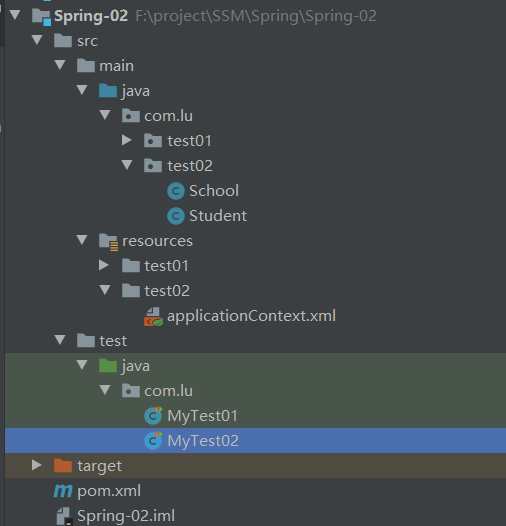
我们首先定义一个School类
packagecom.lu.test02;publicclassSchool{privateString name;privateString address;publicvoidsetName(String name){this.name = name;}publicvoidsetAddress(String address){this.address = address;}@OverridepublicStringtoString(){return"School{"+"name='"+ name +'\''+", address='"+ address +'\''+'}';}}
再定义一个Student类
packagecom.lu.test02;publicclassStudent{privateString name;privateint age;//引用类型privateSchool school;publicStudent(){System.out.println("Student类的无参构造方法执行了....");}publicvoidsetName(String name){System.out.println("setName == "+ name);this.name = name;}publicvoidsetAge(int age){System.out.println("setAge == "+ age);this.age = age;}publicvoidsetSchool(School school){System.out.println("setSchool == "+ school);this.school = school;}@OverridepublicStringtoString(){return"Student{"+"name='"+ name +'\''+", age="+ age +", school="+ school +'}';}}
我们来编写applicationContext.xml文件
<?xml version="1.0" encoding="UTF-8"?><beansxmlns="http://www.springframework.org/schema/beans"xmlns:xsi="http://www.w3.org/2001/XMLSchema-instance"xsi:schemaLocation="http://www.springframework.org/schema/beans http://www.springframework.org/schema/beans/spring-beans.xsd"><!--声明bean--><!--
DI:给属性赋值
简单类型:java中的基本数据类型和String
1.set注入:spring调用类的set方法,通过set方法完成属性赋值
简单类型的set注入:
语法:<bean id="xxx" class="yyyy">
<property name="属性名" value="简单类型属性值"/>
....
</bean>
2.set注入:
引用类型set注入:
语法:
<bean id="xxx" class="yyy">
<property name="属性名" ref="bean的id"/>
...
</bean>
--><beanid="myStudent"class="com.lu.test02.Student"><propertyname="name"value="张三"></property><propertyname="age"value="20"></property><propertyname="school"ref="mySchool"></property></bean><!--声明school--><beanid="mySchool"class="com.lu.test02.School"><propertyname="name"value="清华大学"></property><propertyname="address"value="北京"></property></bean></beans>
我们来编写测试类:
@Testpublicvoidtest01(){String config ="test02/applicationContext.xml";ApplicationContext ctx =newClassPathXmlApplicationContext(config);Student student =(Student)ctx.getBean("myStudent");System.out.println(student);}
控制台输出:

我们可以看到,对于引用类型的赋值,我们必须使用ref来引用
格式为:
<beanid="xxx"class="yyy"><propertyname="属性名"ref="引用类型的bean的id"/>
...
</bean>
2.5.1.2 构造注入
构造注入:spring调用类中的有参构造方法,在创建对象的同时,给属性赋值。
我们举个例子,首先修改Student类,School类不需要修改
packagecom.lu.test03;publicclassStudent{privateString name;privateint age;//引用类型privateSchool school;publicStudent(){System.out.println("Student类的无参构造方法执行了....");}publicStudent(String name,int age,School school){System.out.println("Student的有参构造方法执行了...");this.name = name;this.age = age;this.school = school;}@OverridepublicStringtoString(){return"Student{"+"name='"+ name +'\''+", age="+ age +", school="+ school +'}';}}
再来修改applicationContext.xml文件
<?xml version="1.0" encoding="UTF-8"?><beansxmlns="http://www.springframework.org/schema/beans"xmlns:xsi="http://www.w3.org/2001/XMLSchema-instance"xsi:schemaLocation="http://www.springframework.org/schema/beans http://www.springframework.org/schema/beans/spring-beans.xsd"><!--
构造注入:spring调用类的有参构造方法,创建对象同时给属性赋值
语法:
<bean id="xxx" class="yyy">
<constructor-arg>:表示一个构造方法的形参
标签有属性:name:构造方法形参名
index:构造方法的参数位置
value:简单类型的形参值
ref:引用类型的形参值
--><beanid="myStudent"class="com.lu.test03.Student"><constructor-argname="name"value="李四"></constructor-arg><constructor-argname="age"value="25"></constructor-arg><constructor-argname="school"ref="mySchool"></constructor-arg></bean><!--声明school--><beanid="mySchool"class="com.lu.test03.School"><propertyname="name"value="清华大学"></property><propertyname="address"value="北京"></property></bean></beans>
我们来编写测试类:
packagecom.lu;importcom.lu.test03.Student;importorg.junit.Test;importorg.springframework.context.ApplicationContext;importorg.springframework.context.support.ClassPathXmlApplicationContext;publicclassMyTest03{@Testpublicvoidtest01(){String config ="test03/applicationContext.xml";ApplicationContext ctx =newClassPathXmlApplicationContext(config);Student student =(Student)ctx.getBean("myStudent");System.out.println(student);}}
控制台输出:

我们发现成功了,这种方法我们指定的是形参的name,还有一种方式是指定形参的index,从左往右进行指定,分别为0,1,2,3…等
我们来试验一下,修改applicationContext.xml文件
<?xml version="1.0" encoding="UTF-8"?><beansxmlns="http://www.springframework.org/schema/beans"xmlns:xsi="http://www.w3.org/2001/XMLSchema-instance"xsi:schemaLocation="http://www.springframework.org/schema/beans http://www.springframework.org/schema/beans/spring-beans.xsd"><!--
构造注入:spring调用类的有参构造方法,创建对象同时给属性赋值
语法:
<bean id="xxx" class="yyy">
<constructor-arg>:表示一个构造方法的形参
标签有属性:name:构造方法形参名
index:构造方法的参数位置
value:简单类型的形参值
ref:引用类型的形参值
--><!--构造注入,使用index,参数的位置,构造方法参数从左往右的位置是0,1,2...--><beanid="myStudent2"class="com.lu.test03.Student"><constructor-argindex="0"value="李武"></constructor-arg><constructor-argindex="1"value="34"></constructor-arg><constructor-argindex="2"ref="mySchool"></constructor-arg></bean><!--声明school--><beanid="mySchool"class="com.lu.test03.School"><propertyname="name"value="清华大学"></property><propertyname="address"value="北京"></property></bean></beans>
编写测试类:
@Testpublicvoidtest2(){String config ="test03/applicationContext.xml";ApplicationContext ctx =newClassPathXmlApplicationContext(config);Student student =(Student) ctx.getBean("myStudent2");System.out.println(student);}
控制台输出:

我们看到执行成功了,成功创建对象
甚至我们可以再省略一点,把index也给省略掉,但是我们的顺序必须严格按照形参的顺序来写
我们试验一下,我们来改写applicationContext.xml文件
<?xml version="1.0" encoding="UTF-8"?><beansxmlns="http://www.springframework.org/schema/beans"xmlns:xsi="http://www.w3.org/2001/XMLSchema-instance"xsi:schemaLocation="http://www.springframework.org/schema/beans http://www.springframework.org/schema/beans/spring-beans.xsd"><!--
构造注入:spring调用类的有参构造方法,创建对象同时给属性赋值
语法:
<bean id="xxx" class="yyy">
<constructor-arg>:表示一个构造方法的形参
标签有属性:name:构造方法形参名
index:构造方法的参数位置
value:简单类型的形参值
ref:引用类型的形参值
--><!--构造注入,省略index属性--><beanid="myStudent3"class="com.lu.test03.Student"><constructor-argvalue="张三丰"></constructor-arg><constructor-argvalue="58"></constructor-arg><constructor-argref="mySchool"></constructor-arg></bean><!--声明school--><beanid="mySchool"class="com.lu.test03.School"><propertyname="name"value="清华大学"></property><propertyname="address"value="北京"></property></bean></beans>
编写测试类:
@Testpublicvoidtest3(){String config ="test03/applicationContext.xml";ApplicationContext ctx =newClassPathXmlApplicationContext(config);Student student =(Student) ctx.getBean("myStudent3");System.out.println(student);}
控制台输出:

我们也创建成功了,但值得注意的是,我们在日常使用中,通常不会选择构造注入,都是通过设值注入来创建对象。
2.5.1.2.1 通过构造注入创建File对象
我们首先查看File类的构造方法

我们可以看到需要一个child和一个parent
我们来编写applicationContext.xml文件
<?xml version="1.0" encoding="UTF-8"?><beansxmlns="http://www.springframework.org/schema/beans"xmlns:xsi="http://www.w3.org/2001/XMLSchema-instance"xsi:schemaLocation="http://www.springframework.org/schema/beans http://www.springframework.org/schema/beans/spring-beans.xsd"><!--生命File对象--><beanid="myFile"class="java.io.File"><constructor-argname="parent"value="C:\Users\Administrator.LAPTOP-62FQ379R\Desktop"></constructor-arg><constructor-argname="child"value="新建 文本文档.txt"></constructor-arg></bean></beans>
编写测试类:
@Testpublicvoidtest4(){String config ="test03/applicationContext.xml";ApplicationContext ctx =newClassPathXmlApplicationContext(config);//获取File对象File file =(File) ctx.getBean("myFile");System.out.println(file.getName());}
控制台输出:

我们发现对象成功创建了,也就是说,创建类的对象,我们不能仅仅局限于自己自定义的类,非自定义的类我们同样也可以创建对象
2.5.1.3 引用类型的自动注入
概念:spring可以根据某些规则给引用类型完成赋值。只对引用类型有效。
规则byName,byType
首先我们重新创建一个项目,该项目拷贝test02的
School类
packagecom.lu.test04;publicclassSchool{privateString name;privateString address;publicvoidsetName(String name){this.name = name;}publicvoidsetAddress(String address){this.address = address;}@OverridepublicStringtoString(){return"School{"+"name='"+ name +'\''+", address='"+ address +'\''+'}';}}
Student类:
packagecom.lu.test04;publicclassStudent{privateString name;privateint age;//引用类型privateSchool school;publicStudent(){System.out.println("Student类的无参构造方法执行了....");}publicvoidsetName(String name){System.out.println("setName == "+ name);this.name = name;}publicvoidsetAge(int age){System.out.println("setAge == "+ age);this.age = age;}publicvoidsetSchool(School school){System.out.println("setSchool == "+ school);this.school = school;}@OverridepublicStringtoString(){return"Student{"+"name='"+ name +'\''+", age="+ age +", school="+ school +'}';}}
applicationContext.xml文件
<?xml version="1.0" encoding="UTF-8"?><beansxmlns="http://www.springframework.org/schema/beans"xmlns:xsi="http://www.w3.org/2001/XMLSchema-instance"xsi:schemaLocation="http://www.springframework.org/schema/beans http://www.springframework.org/schema/beans/spring-beans.xsd"><beanid="myStudent"class="com.lu.test04.Student"><propertyname="name"value="张三"></property><propertyname="age"value="20"></property><propertyname="school"ref="mySchool"></property></bean><!--声明school--><beanid="mySchool"class="com.lu.test04.School"><propertyname="name"value="清华大学"></property><propertyname="address"value="北京"></property></bean></beans>
测试类:
package com.lu;import com.lu.test04.Student;import org.junit.Test;import org.springframework.context.ApplicationContext;import org.springframework.context.support.ClassPathXmlApplicationContext;publicclassMyTest04{
@Test
publicvoidtest01(){
String config ="test04/applicationContext.xml";
ApplicationContext ctx =newClassPathXmlApplicationContext(config);
Student student =(Student) ctx.getBean("myStudent");
System.out.println(student);}}
控制台输出:

我们就根据这个项目来改
2.5.1.3.1 byName(按名称注入)
Java类中引用类型属性名称和spring容器中bean的id名称一样的,且数据类型也是一样的,这些bean能够赋值给引用类型。
我们来修改applicationContext.xml文件
<?xml version="1.0" encoding="UTF-8"?><beansxmlns="http://www.springframework.org/schema/beans"xmlns:xsi="http://www.w3.org/2001/XMLSchema-instance"xsi:schemaLocation="http://www.springframework.org/schema/beans http://www.springframework.org/schema/beans/spring-beans.xsd"><!--
byName(按名称注入):java类中引用类型的属性名称和spring容器中bean的id名称一样,且数据类型一样,这样的bean能够赋值给引用类型
语法:
<bean id="xxx" class="yyy" autowire="byName">
简单类型属性赋值
</bean>
--><!--byName自动注入--><beanid="myStudent"class="com.lu.test04.Student"autowire="byName"><propertyname="name"value="张三"></property><propertyname="age"value="20"></property></bean><!--声明school--><beanid="school"class="com.lu.test04.School"><propertyname="name"value="北京航空航天大学"></property><propertyname="address"value="北京"></property></bean></beans>
我们重新执行一下测试类,控制台输出:

我们发现成功了!
2.5.1.3.2 byType(按类型注入)
Java类中引用类型的数据类型和spring容器中bean的class值是同源关系的,这样的bean赋值给引用类型。
我们新建一个test05项目,和上面的步骤一样
修改applicationContext.xml文件
<?xml version="1.0" encoding="UTF-8"?><beansxmlns="http://www.springframework.org/schema/beans"xmlns:xsi="http://www.w3.org/2001/XMLSchema-instance"xsi:schemaLocation="http://www.springframework.org/schema/beans http://www.springframework.org/schema/beans/spring-beans.xsd"><!--
byType:Java类中引用类型的数据类型和spring容器中bean的class值是同源关系的,这样的bean赋值给引用类型。
同源关系:
1.java中引用类型的数据类型和bean的class值是一样的
2.java中引用类型的数据类型和bean的class值是父子类关系的
3.java中引用类型的数据类型和bean的class值是接口和实现类关系的
语法:
<bean id="xxx" class="yyy" autowire="byType">
简单类型属性赋值
</bean>
--><!--byType自动注入--><beanid="myStudent"class="com.lu.test05.Student"autowire="byType"><propertyname="name"value="周星驰"></property><propertyname="age"value="56"></property></bean><!--声明school--><beanid="mySchool"class="com.lu.test05.School"><propertyname="name"value="北京电子信息大学"></property><propertyname="address"value="北京"></property></bean></beans>
重新运行测试类,控制台输出:

我们发现有几点需要注意的是,school类的bean的id不一样和引用类型的属性名一致,只需要class一样即可。这是同源关系的第一种情况,即引用类型的数据类型和bean的class值是一样的。
我们来测试同源关系的第二种情况,即引用类型的数据类型和和bean的class值是父子类关系
我们来编写School类的子类
packagecom.lu.test05;publicclassPrimarySchoolextendsSchool{}
applicationContext.xml文件:
<?xml version="1.0" encoding="UTF-8"?><beansxmlns="http://www.springframework.org/schema/beans"xmlns:xsi="http://www.w3.org/2001/XMLSchema-instance"xsi:schemaLocation="http://www.springframework.org/schema/beans http://www.springframework.org/schema/beans/spring-beans.xsd"><!--
byType:Java类中引用类型的数据类型和spring容器中bean的class值是同源关系的,这样的bean赋值给引用类型。
同源关系:
1.java中引用类型的数据类型和bean的class值是一样的
2.java中引用类型的数据类型和bean的class值是父子类关系的
3.java中引用类型的数据类型和bean的class值是接口和实现类关系的
语法:
<bean id="xxx" class="yyy" autowire="byType">
简单类型属性赋值
</bean>
--><!--byType自动注入--><beanid="myStudent"class="com.lu.test05.Student"autowire="byType"><propertyname="name"value="周星驰"></property><propertyname="age"value="56"></property></bean><!--声明school的子类--><beanid="primarySchool"class="com.lu.test05.PrimarySchool"><propertyname="name"value="北京大学附属小学"></property><propertyname="address"value="北京市"></property></bean></beans>
运行测试类,控制台输出:

赋值成功了,第二种情况也可以
2.5.1.4 项目中使用多个spring配置文件
分多个配置文件的方式:
- 按功能模块分,一个模块一个配置文件
- 按类的功能分,数据库操作相关的类在一个文件,service类在一个配置文件,配置redis,事务等等的一个配置文件
spring管理多个配置文件:常用的是包含关系的配置文件。项目中有一个总的文件,里面是有import标签包含其他的多个配置文件。
语法:
总的文件(xml)
<import resource="classpath:其他的文件的路径1"/>
<import resource="classpath:其他的文件的路径2"/>
关键字"classpath":表示类路径,也就是类文件(class文件)所在的目录。spring通过类路径中加载文件
什么时候使用classpath:在一个文件中要使用其他的文件需要使用classpath
我们来写一个例子:

spring-school配置文件:
<?xml version="1.0" encoding="UTF-8"?><beansxmlns="http://www.springframework.org/schema/beans"xmlns:xsi="http://www.w3.org/2001/XMLSchema-instance"xsi:schemaLocation="http://www.springframework.org/schema/beans http://www.springframework.org/schema/beans/spring-beans.xsd"><!--School类相关声明--><beanid="school"class="com.lu.test06.School"><propertyname="name"value="北京大学"></property><propertyname="address"value="北京市"></property></bean></beans>
spring-student配置文件:
<?xml version="1.0" encoding="UTF-8"?><beansxmlns="http://www.springframework.org/schema/beans"xmlns:xsi="http://www.w3.org/2001/XMLSchema-instance"xsi:schemaLocation="http://www.springframework.org/schema/beans http://www.springframework.org/schema/beans/spring-beans.xsd"><!--学生模块的bean--><beanid="myStudent"class="com.lu.test06.Student"autowire="byType"><propertyname="name"value="周星驰"></property><propertyname="age"value="56"></property></bean></beans>
applicationContext.xml配置文件:
<?xml version="1.0" encoding="UTF-8"?><beansxmlns="http://www.springframework.org/schema/beans"xmlns:xsi="http://www.w3.org/2001/XMLSchema-instance"xsi:schemaLocation="http://www.springframework.org/schema/beans http://www.springframework.org/schema/beans/spring-beans.xsd"><!--总的文件,目的是包含其他的多个配置文件,一般不声明bean
语法:
<import resource="classpath:其他文件的路径"/>
关键字"classpath":表示类路径,也就是类文件(class文件)所在的目录。spring通过类路径中加载文件
--><importresource="classpath:test06/spring-student.xml"></import><importresource="classpath:test06/spring-school.xml"></import></beans>
测试类:
packagecom.lu;importcom.lu.test06.Student;importorg.junit.Test;importorg.springframework.context.ApplicationContext;importorg.springframework.context.support.ClassPathXmlApplicationContext;publicclassMyTest06{@Testpublicvoidtest01(){String config ="test06/applicationContext.xml";ApplicationContext ctx =newClassPathXmlApplicationContext(config);Student student =(Student) ctx.getBean("myStudent");System.out.println(student);}}
控制台输出:

可以了,成功输出!
除了上面这种方法,我们还可以使用通配符来使用
我们修改applicationContext.xml文件
<!--通配符(*:表示任意字符)--><importresource="classpath:test06/spring-*.xml"></import>
这样我们一行代码就可以引入多个配置文件,但有一点注意的是,总的文件名称,不能包含在通配符范围内
2.5.2 基于注解的DI
基于注解的DI:使用spring提供的注解,完成java对象的创建,属性的赋值
注解使用的核心步骤:
- 在源代码加入注解,例如@Component
- 在spring的配置文件,加入组件扫描器的标签
我们来举一个例子
首先看一下目录结构
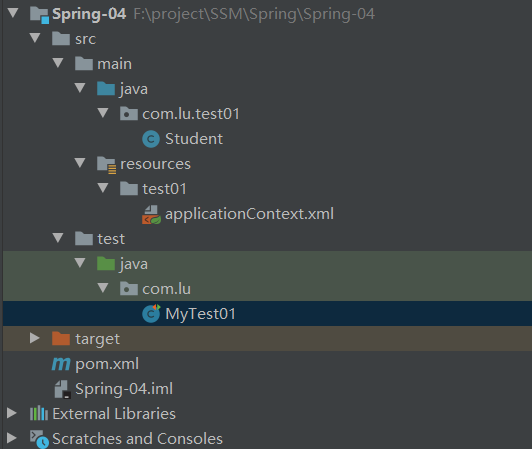
首先创建一个Student类
packagecom.lu.test01;importorg.springframework.stereotype.Component;/**
*
* @Component:表示创建对象,对象放到容器中,作用是<bean></bean>
* 属性:value,表示对象名称,也就是bean的id属性值
* 位置:在类的上面,表示创建此类的对象
*
* @Component(value = "myStudent") 等同于
* <bean id="myStudent" class="com.lu.test01.Student"></bean>
*
* */@Component(value ="myStudent")publicclassStudent{privateString name;privateint age;publicStudent(){System.out.println("Student的无参构造方法执行了...");}@OverridepublicStringtoString(){return"Student{"+"name='"+ name +'\''+", age="+ age +'}';}}
applicationContext.xml文件
<?xml version="1.0" encoding="UTF-8"?><beansxmlns="http://www.springframework.org/schema/beans"xmlns:xsi="http://www.w3.org/2001/XMLSchema-instance"xmlns:context="http://www.springframework.org/schema/context"xsi:schemaLocation="http://www.springframework.org/schema/beans http://www.springframework.org/schema/beans/spring-beans.xsd http://www.springframework.org/schema/context https://www.springframework.org/schema/context/spring-context.xsd"><!--声明组件扫描器:使用注解必须加入这个语句
component-scan:翻译过来就是组件扫描器,组件是java对象
属性:base-package 注解在你的项目中的包名
框架会扫描这个包和子包中的所有类,找类中的所有注解
遇到注解后,按照注解表示的功能,去创建对象,给属性赋值
--><context:component-scanbase-package="com.lu.test01"></context:component-scan></beans>
编写测试类:
packagecom.lu;importcom.lu.test01.Student;importorg.junit.Test;importorg.springframework.context.ApplicationContext;importorg.springframework.context.support.ClassPathXmlApplicationContext;publicclassMyTest01{@Testpublicvoidtest01(){String config ="test01/applicationContext.xml";ApplicationContext ctx =newClassPathXmlApplicationContext(config);Student student =(Student) ctx.getBean("myStudent");System.out.println(student);}}
控制台输出:

输出成功,说明使用@Component注解成功创建对象了。
值得注意的是,@Component()里面也可以不写value,直接写@Component(“myStudent”)
也可以不提供自定义对象名称,使用框架的默认名称:类名首字母小写
和@Component功能相同的创建对象的注解
@Repository:放在dao接口的实现类上面,表示创建dao对象,持久层对象,能访问数据库
@Service:放在业务层接口的实现类上面,表示创建业务层对象,业务层对象有事务的功能
@Controller:放在控制器类的上面,表示创建控制器对象,数据表示层对象
控制层对象能接受请求,把请求的处理结果显示给用户
以上四个注解都能创建对象,但是@Repository @Service @Controller有角色说明,表示对象是分层的
对象是属于不同层的,具有额外的功能
2.5.2.1 扫描包的三种方式
我们在applicationContext.xml文件中来说明
<?xml version="1.0" encoding="UTF-8"?><beansxmlns="http://www.springframework.org/schema/beans"xmlns:xsi="http://www.w3.org/2001/XMLSchema-instance"xmlns:context="http://www.springframework.org/schema/context"xsi:schemaLocation="http://www.springframework.org/schema/beans http://www.springframework.org/schema/beans/spring-beans.xsd http://www.springframework.org/schema/context https://www.springframework.org/schema/context/spring-context.xsd"><!--扫描多个包的三种方式--><!--第一种,使用多次组件扫描器--><context:component-scanbase-package="com.lu.test01"></context:component-scan><context:component-scanbase-package="com.lu.test02"></context:component-scan><!--第二种,使用分隔符(, 或者 ;),指定多个包--><context:component-scanbase-package="com.lu.test01;com.lu.test02"></context:component-scan><!--第三种:指定父包--><context:component-scanbase-package="com.lu"></context:component-scan></beans>
2.5.2.2 简单类型赋值
Student类
packagecom.lu.test02;importorg.springframework.beans.factory.annotation.Value;importorg.springframework.stereotype.Component;@Component("myStudent")publicclassStudent{/**
* 简单类型属性赋值:@Value
* @Value:简单类型属性值
* 属性:value 简单类型属性值
* 位置:1) 在属性定义的上面,无需set方法,推荐使用
* 2) 在set方法的上面
* */@Value(value ="张三")privateString name;@Value(value ="24")privateint age;publicStudent(){System.out.println("Student的无参构造方法执行了...");}@OverridepublicStringtoString(){return"Student{"+"name='"+ name +'\''+", age="+ age +'}';}}
applicationContext.xml文件
<?xml version="1.0" encoding="UTF-8"?><beansxmlns="http://www.springframework.org/schema/beans"xmlns:xsi="http://www.w3.org/2001/XMLSchema-instance"xmlns:context="http://www.springframework.org/schema/context"xsi:schemaLocation="http://www.springframework.org/schema/beans http://www.springframework.org/schema/beans/spring-beans.xsd http://www.springframework.org/schema/context https://www.springframework.org/schema/context/spring-context.xsd"><context:component-scanbase-package="com.lu.test02"></context:component-scan></beans>
测试类:
packagecom.lu;importcom.lu.test02.Student;importorg.junit.Test;importorg.springframework.context.ApplicationContext;importorg.springframework.context.support.ClassPathXmlApplicationContext;publicclassMyTest02{@Testpublicvoidtest01(){String config ="test02/applicationContext.xml";ApplicationContext ctx =newClassPathXmlApplicationContext(config);Student student =(Student) ctx.getBean("myStudent");System.out.println(student);}}
控制台输出:

我们也可以把注解写到set方法上,并且省略value
packagecom.lu.test02;importorg.springframework.beans.factory.annotation.Value;importorg.springframework.stereotype.Component;@Component("myStudent")publicclassStudent{/**
* 简单类型属性赋值:@Value
* @Value:简单类型属性值
* 属性:value 简单类型属性值
* 位置:1) 在属性定义的上面,无需set方法,推荐使用
* 2) 在set方法的上面
* */privateString name;privateint age;@Value("李四")publicvoidsetName(String name){this.name = name;}@Value("32")publicvoidsetAge(int age){this.age = age;}publicStudent(){System.out.println("Student的无参构造方法执行了...");}@OverridepublicStringtoString(){return"Student{"+"name='"+ name +'\''+", age="+ age +'}';}}
控制台输出:
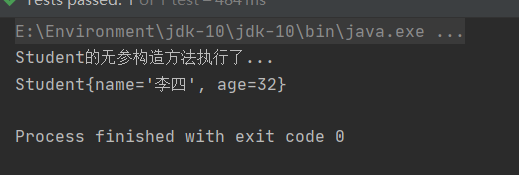
2.5.2.3 使用外部属性配置文件
目录结构
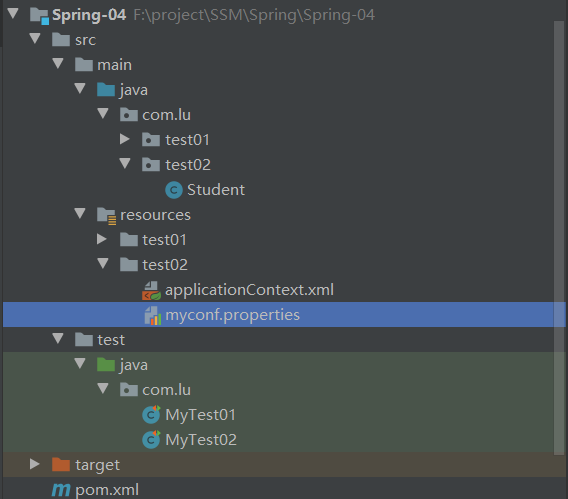
创建myconf.properties
myname=王五
myage=54
Student类:
packagecom.lu.test02;importorg.springframework.beans.factory.annotation.Value;importorg.springframework.stereotype.Component;@Component("myStudent")publicclassStudent{//使用外部属性文件中的数据,语法 ${"key"}@Value("${myname}")privateString name;@Value("${myage}")privateint age;publicStudent(){System.out.println("Student的无参构造方法执行了...");}@OverridepublicStringtoString(){return"Student{"+"name='"+ name +'\''+", age="+ age +'}';}}
applicationContext.xml文件
<?xml version="1.0" encoding="UTF-8"?><beansxmlns="http://www.springframework.org/schema/beans"xmlns:xsi="http://www.w3.org/2001/XMLSchema-instance"xmlns:context="http://www.springframework.org/schema/context"xsi:schemaLocation="http://www.springframework.org/schema/beans http://www.springframework.org/schema/beans/spring-beans.xsd http://www.springframework.org/schema/context https://www.springframework.org/schema/context/spring-context.xsd"><context:component-scanbase-package="com.lu.test02"></context:component-scan><!--读取外部的属性配置文件
property-placeholder:读取properties这样的文件 Property
--><context:property-placeholderfile-encoding="utf-8"location="classpath:/test02/myconf.properties"></context:property-placeholder></beans>
测试类控制台输出:

同样可以,这样我们就可以把属性值放到外部文件中去了
2.5.2.4 @Autowired自动注入byType
目录结构:
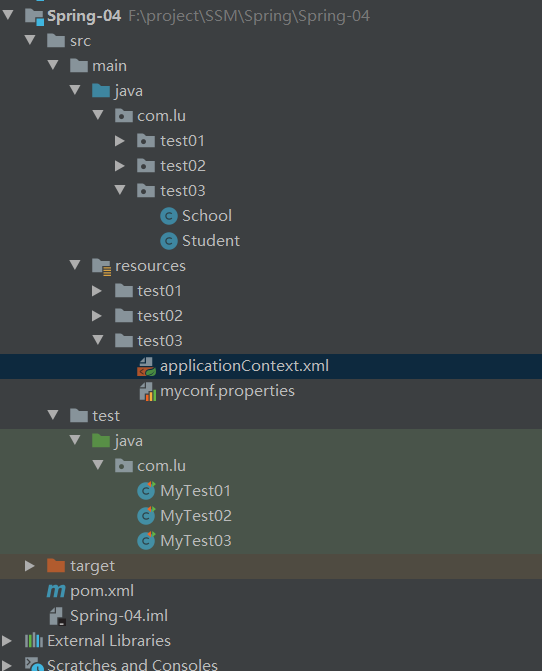
创建School类
packagecom.lu.test03;publicclassSchool{privateString name;privateString address;publicvoidsetName(String name){this.name = name;}publicvoidsetAddress(String address){this.address = address;}@OverridepublicStringtoString(){return"School{"+"name='"+ name +'\''+", address='"+ address +'\''+'}';}}
Student类中声明引用类型School
packagecom.lu.test03;importorg.springframework.beans.factory.annotation.Autowired;importorg.springframework.beans.factory.annotation.Value;importorg.springframework.stereotype.Component;@Component("myStudent")publicclassStudent{@Value("${myname}")privateString name;@Value("${myage}")privateint age;/**
* 引用类型
*
* @Autowired:spring框架提供的,给引用类型赋值的,使用自动注入原理 支持byName, byType, 默认是byType
* 位置:1) 在属性定义的上面,无需set方法,推荐使用
* 2) 在set方法的上面
*///默认使用byType@AutowiredprivateSchool school;publicStudent(){System.out.println("Student的无参构造方法执行了...");}@OverridepublicStringtoString(){return"Student{"+"name='"+ name +'\''+", age="+ age +", school="+ school +'}';}}
applicationContext.xml我呢见
<?xml version="1.0" encoding="UTF-8"?><beansxmlns="http://www.springframework.org/schema/beans"xmlns:xsi="http://www.w3.org/2001/XMLSchema-instance"xmlns:context="http://www.springframework.org/schema/context"xsi:schemaLocation="http://www.springframework.org/schema/beans http://www.springframework.org/schema/beans/spring-beans.xsd http://www.springframework.org/schema/context https://www.springframework.org/schema/context/spring-context.xsd"><context:component-scanbase-package="com.lu.test03"></context:component-scan><!--读取外部的属性配置文件
property-placeholder:读取properties这样的文件 Property
--><context:property-placeholderfile-encoding="utf-8"location="classpath:/test03/myconf.properties"></context:property-placeholder><beanid="mySchool"class="com.lu.test03.School"><propertyname="name"value="北京航空航天大学"></property><propertyname="address"value="北京市"></property></bean></beans>
测试类输出:

我们看到执行成功了
这里我们的school类是在applicationContext.xml文件中用标签来声明的,我们也可以用注解的方式来给school类进行赋值
2.5.2.5 @Autowired自动注入byName
结合上面的项目,我们只需要改动Student类
packagecom.lu.test04;importorg.springframework.beans.factory.annotation.Autowired;importorg.springframework.beans.factory.annotation.Qualifier;importorg.springframework.beans.factory.annotation.Value;importorg.springframework.stereotype.Component;@Component("myStudent")publicclassStudent{@Value("${myname}")privateString name;@Value("${myage}")privateint age;/**
* 引用类型
*
* @Autowired:spring框架提供的,给引用类型赋值的,使用自动注入原理 支持byName, byType, 默认是byType
* 位置:1) 在属性定义的上面,无需set方法,推荐使用
* 2) 在set方法的上面
*
* byName自动注入:
* 1)@Autowired:给引用类型赋值
* 2)@Qualifier(value="bean的id"):从容器中找到指定名称的对象,把这个对象赋值给引用类型
*///使用byName@Autowired@Qualifier(value ="mySchool")privateSchool school;publicStudent(){System.out.println("Student的无参构造方法执行了...");}@OverridepublicStringtoString(){return"Student{"+"name='"+ name +'\''+", age="+ age +", school="+ school +'}';}}
控制台输出:

2.5.2.6 @Resource注解
School类:
packagecom.lu.test06;importorg.springframework.beans.factory.annotation.Value;importorg.springframework.stereotype.Component;@Component("mySchool")publicclassSchool{@Value("北京大学")privateString name;@Value("北京市")privateString address;publicvoidsetName(String name){this.name = name;}publicvoidsetAddress(String address){this.address = address;}@OverridepublicStringtoString(){return"School{"+"name='"+ name +'\''+", address='"+ address +'\''+'}';}}
Student类:
packagecom.lu.test06;importorg.springframework.beans.factory.annotation.Autowired;importorg.springframework.beans.factory.annotation.Qualifier;importorg.springframework.beans.factory.annotation.Value;importorg.springframework.stereotype.Component;importjavax.annotation.Resource;@Component("myStudent")publicclassStudent{@Value("${myname}")privateString name;@Value("${myage}")privateint age;/**
* 引用类型
* @Resource:来自jdk中,给引用类型赋值的,支持byName,byType,默认是byName
* spring支持这个注解的使用
* 位置:1)在属性定义的上面,无需set方法,推荐使用
* 2)在set方法的上面
*
*
*
* 说明:高于jdk1.8没有@Resource,需要加入一个依赖
* <dependency>
* <groupId>javax.annotation</groupId>
* <artifactId>javax.annotation-api</artifactId>
* <version>1.3.2</version>
* </dependency>
* *///默认是byName 自动注入//先使用byName,赋值失败在使用byType@ResourceprivateSchool school;publicStudent(){System.out.println("Student的无参构造方法执行了...");}@OverridepublicStringtoString(){return"Student{"+"name='"+ name +'\''+", age="+ age +", school="+ school +'}';}}
aplicationContext.xml文件:
<?xml version="1.0" encoding="UTF-8"?><beansxmlns="http://www.springframework.org/schema/beans"xmlns:xsi="http://www.w3.org/2001/XMLSchema-instance"xmlns:context="http://www.springframework.org/schema/context"xsi:schemaLocation="http://www.springframework.org/schema/beans http://www.springframework.org/schema/beans/spring-beans.xsd http://www.springframework.org/schema/context https://www.springframework.org/schema/context/spring-context.xsd"><context:component-scanbase-package="com.lu.test06"></context:component-scan><!--读取外部的属性配置文件
property-placeholder:读取properties这样的文件 Property
--><context:property-placeholderfile-encoding="utf-8"location="classpath:/test06/myconf.properties"></context:property-placeholder></beans>
控制台输出:

@Resource默认是byName,赋值失败会自动转换成byType,如果只用byName,而不是转换成byType
我们需要修改Student类
packagecom.lu.test07;importorg.springframework.beans.factory.annotation.Value;importorg.springframework.stereotype.Component;importjavax.annotation.Resource;@Component("myStudent")publicclassStudent{@Value("${myname}")privateString name;@Value("${myage}")privateint age;/**
* 引用类型
* @Resource:来自jdk中,给引用类型赋值的,支持byName,byType,默认是byName
* spring支持这个注解的使用
* 位置:1)在属性定义的上面,无需set方法,推荐使用
* 2)在set方法的上面
*
*
*
* 说明:高于jdk1.8没有@Resource,需要加入一个依赖
* <dependency>
* <groupId>javax.annotation</groupId>
* <artifactId>javax.annotation-api</artifactId>
* <version>1.3.2</version>
* </dependency>
*
* @Reource只是用byName赋值
* 使用注解属性name="bean的id"
* *///只是用byName@Resource(name ="mySchool")privateSchool school;publicStudent(){System.out.println("Student的无参构造方法执行了...");}@OverridepublicStringtoString(){return"Student{"+"name='"+ name +'\''+", age="+ age +", school="+ school +'}';}}
3 AOP面相切面编程
3.1 增加功能,导致的问题
在源代码中,业务方法中增加的功能
- 源代码可能改动的比较多
- 重复代码比较多
- 代码难于维护
3.2 一个静态代理的例子
项目的目录结构
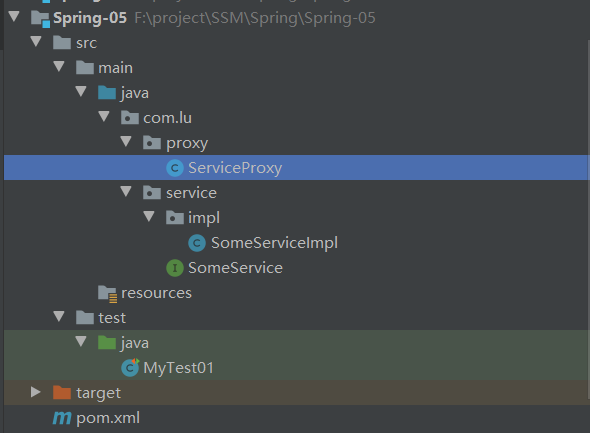
创建SomeService接口
packagecom.lu.service;publicinterfaceSomeService{voiddoSome();voiddoOther();}
创建SomeServiceImpl实现该接口
packagecom.lu.service.impl;importcom.lu.service.SomeService;publicclassSomeServiceImplimplementsSomeService{@OverridepublicvoiddoSome(){System.out.println("业务方法doSome执行了。。。。");}@OverridepublicvoiddoOther(){System.out.println("业务方法doOther执行了。。。。");}}
创建静态代理类
packagecom.lu.proxy;importcom.lu.service.SomeService;importcom.lu.service.impl.SomeServiceImpl;importjava.util.Date;/**
* 调用ServiceProxy类方法的时候,调用真正的目标方法
* 调用目标方法的时候,增加一些功能
*
* ServiceProxy叫做代理,代理对目标的操作
*
* 创建代理,可以完成对目标方法的调用,增减功能
* 保持目标方法内容不变
* */publicclassServiceProxyimplementsSomeService{SomeService target =newSomeServiceImpl();@OverridepublicvoiddoSome(){System.out.println("日志功能,当前时间为:"+newDate());
target.doSome();System.out.println("提交事务");}@OverridepublicvoiddoOther(){System.out.println("日志功能,当前时间为:"+newDate());
target.doOther();System.out.println("提交事务");}}
测试类中进行测试
importcom.lu.proxy.ServiceProxy;importcom.lu.service.SomeService;importcom.lu.service.impl.SomeServiceImpl;importorg.junit.Test;publicclassMyTest01{@Testpublicvoidtest01(){SomeService service =newServiceProxy();
service.doSome();System.out.println("===========================");
service.doOther();}}
控制台输出:

从这个例子中我们可以看待代理给我们带来的便利
3.3 AOP概念
什么是AOP?
AOP(Aspect Orient Programming):面向切面编程
Aspect:表示切面,给业务方法增加的功能,叫做切面。切面一般都是非业务功能,而且切面功能一般都是可以复用的。
例如:日志功能,权限检查,统计信息等等
Orient:面向
Programming:编程
怎么理解面向切面编程?
- 设计项目时,找出切面的功能
- 安排切面的执行时间,执行的位置
AOP作用
- 让切面功能复用
- 让开发人员专注业务逻辑,提高开发效率
- 实现业务功能和其他非业务功能解耦合
- 给存在的业务方法,增加功能,不用修改原来的代码
AOP中术语
- Aspect:切面,给业务方法增加的功能
- JoinPoint:连接点,连接切面的业务方法。在这个业务方法执行时,会同时执行切面的功能
- Pointcut:切入点,是一个或多个连接点集合。表示这些方法执行时,都能增加切面的功能。表示切面执行的位置
- target:目标对象,给哪个对象增加切面的功能,这个对象就是目标对象
- Advice:通知(增强),表示切面的执行时间。在目标方法之前执行切面,还是目标方法之后执行切面
AOP中重要的三个要素:Aspect,Pointcut,Advice
这个概念的理解是:在Advice的事件,在Pointcut的位置,执行Aspect
AOP是一个动态的思想,是在程序的运行时间,创建代理(ServiceProxy),使用代理执行方法时,增加切面的功能。这个代理对象是存在内存中的。
什么时候用AOP?
你要给某些方法增加相同的功能,源代码不能改。给业务方法增加非业务功能,也可以使用AOP
3.4 AOP技术思想的实现
使用框架实现AOP,实现AOP的框架有很多,有名的有两个
- Spring:Spring框架实现AOP思想中的部分功能。Spring框架实现AOP的操作比较繁琐,笨重
- Aspectj:独立的框架,专门做AOP。属于Eclipse
3.5 使用AspectJ框架实现AOP
AspectJ框架可以使用注解和xml配置文件两种方式实现AOP
3.5.1 通知
AspectJ表示切面执行时间,用的通知(Advice)。这个通知可以使用注解表示。
讲5个注解,表示切面的5个执行时间,这些注解叫做通知注解
@Before:前置通知
@AfterReturning:后置通知
@Around:环绕通知
@AfterThrowing:异常通知
@After:最终通知
3.5.2 Pointcut位置
Pointcut用来表示切面执行的位置,使用Aspectj中切入点表达式。
切入点表达式语法:execution(访问权限 返回值类型 包名类名 方法名(参数) 异常类型)
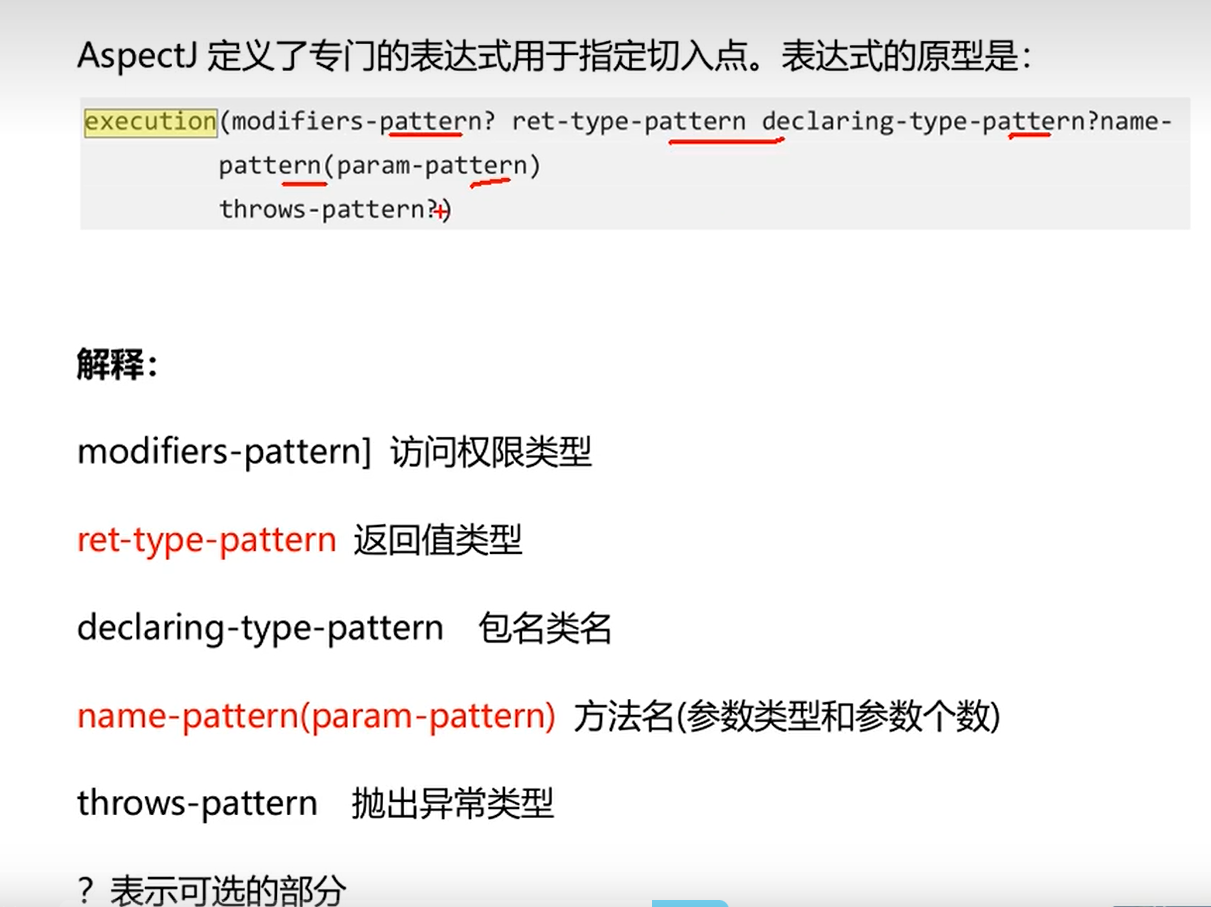
符号意义*0至多个任意字符…用在方法参数中,表示任意多个参数;用在包名后,表示当前包及其子包+用在类名后,表示当前类及其子类;用在接口后,表示当前接口及其实现类
例子:
execution(public * *(…))
指定切入点为:任意公共方法
execution(* set*(…)):指定切入点为
任何一个以"set"开始的方法
execution(* com.lu.service..(…))
指定切入点为:定义在service包里的任意类的任意方法
execution(* com.lu.service…*****.*****(…))
指定切入点为:定义在service包或者子包里的任意类的任意方法
“…“出现在类名中时,后面必须跟”*”,表示包、子包下的所有类
execution(* …service..*(…))
指定所有包下的service子包下所有类(接口)中所有方法为切入点
3.5.3 @Before 前置通知
在目标方法执行之前执行。被注解为前置通知的方法,可以包含一个 JoinPoint 类型参数。该类型的对象本身就是切入点表达式。通过该参数,可获取切入点表达式、方法签名、目标对象等。
不光前置通知的方法,可以包含一个 JoinPoint 类型参数,所有的通知方法均可包含该参数。
步骤:
使用aspectj框架的注解,实现前置通知
实现步骤:
1.新建maven项目
2.修改pom.xml 加入依赖
spring-context依赖, spring-aspects依赖(能使用aspectj框架的功能)
junit
3.创建业务接口和实现类
4.创建一个叫做切面类,是一个普通类
1) 在类的上面加入@Aspect
2) 在类中定义方法,方法表示切面的功能
在方法的上面加入Aspect框架中的通知注解,例如@Before(value="切入点表达式")
5.创建spring配置文件
1) 声明目标对象
2) 声明切面类对象
3) 声明自动代理生成器
6.创建测试类,测试目标方法执行时,增加切面的功能
pom.xml文件:
<?xml version="1.0" encoding="UTF-8"?><projectxmlns="http://maven.apache.org/POM/4.0.0"xmlns:xsi="http://www.w3.org/2001/XMLSchema-instance"xsi:schemaLocation="http://maven.apache.org/POM/4.0.0 http://maven.apache.org/xsd/maven-4.0.0.xsd"><modelVersion>4.0.0</modelVersion><groupId>org.example</groupId><artifactId>Spring-07</artifactId><version>1.0-SNAPSHOT</version><properties><project.build.sourceEncoding>UTF-8</project.build.sourceEncoding><maven.compiler.source>10</maven.compiler.source><maven.compiler.target>10</maven.compiler.target></properties><dependencies><dependency><groupId>junit</groupId><artifactId>junit</artifactId><version>4.13.2</version><scope>test</scope></dependency><dependency><groupId>org.springframework</groupId><artifactId>spring-context</artifactId><version>5.3.4</version></dependency><dependency><groupId>org.springframework</groupId><artifactId>spring-aspects</artifactId><version>4.3.19.RELEASE</version></dependency></dependencies></project>
业务接口:
packagecom.lu.service;publicinterfaceSomeService{publicvoiddoSome(String name,Integer age);}
实现类:
packagecom.lu.service.impl;importcom.lu.service.SomeService;publicclassSomeServiceImplimplementsSomeService{@OverridepublicvoiddoSome(String name,Integer age){System.out.println("业务方法doSome(),创建商品的订单");}}
切面类:
packagecom.lu.handle;importorg.aspectj.lang.JoinPoint;importorg.aspectj.lang.annotation.Aspect;importorg.aspectj.lang.annotation.Before;importjava.util.Date;/**
* @author lucycia
* @Aspect:切面类的注解
* 位置:放在某个类的上面
* 作用:表示当前类时切面类
* 切面类:表示切面功能的类
*/@AspectpublicclassMyAspect{//定义方法,表示切面的具体功能/**
* 前置通知方法的定义
* 1) 方法时public
* 2) 方法时void
* 3) 方法名称自定义
* 4) 方法可以有参数,如果有就是JoinPoint
* 也可以没有
* *//**
* @Before:前置通知
* 属性:value 切入点表达式,表示切面的执行位置
* 在这个方法时,会同时执行切面的功能
* 位置:在方法的上面
*
* 特点:
* 1)执行时间:在目标方法之前先执行
* 2)不会影响目标方法的执行
* 3)不会修改目标方法的执行结果
* */// @Before(value = "execution(public void com.lu.service.impl.SomeServiceImpl.doSome(String,Integer) )")// public void myBefore() {// //切面的代码。// System.out.println("前置通知,切面的功能,在目标方法之前先执行" + new Date());// }// @Before(value = "execution(* *..SomeServiceImpl.do*(..) )")// public void myBefore() {// //切面的代码。// System.out.println("前置通知,切面的功能,在目标方法之前先执行.." + new Date());// }/**
* 切面类中的通知方法,可以有参数
* JoinPoint必须是他
*
* JoinPoint:表示正在执行的业务方法,相当于反射中的Method
* 使用要求:必须是参数列表的第一个
* 作用:获取方法执行时的信息,例如方法名称,方法的参数集合
* */@Before(value ="execution(* *..SomeServiceImpl.do*(..) )")publicvoidmyBefore(JoinPoint jp){//获取方法的定义System.out.println("前置通知中,获取目标方法的定义:"+ jp.getSignature());System.out.println("前置通知中,获取目标方法的名称:"+ jp.getSignature().getName());//获取方法执行时参数Object[] args = jp.getArgs();for(Object obj :
args){System.out.println(obj);}//切面的代码。System.out.println("前置通知,切面的功能,在目标方法之前先执行.."+newDate());}}
spring配置文件:
<?xml version="1.0" encoding="UTF-8"?><beansxmlns="http://www.springframework.org/schema/beans"xmlns:xsi="http://www.w3.org/2001/XMLSchema-instance"xmlns:aop="http://www.springframework.org/schema/aop"xsi:schemaLocation="http://www.springframework.org/schema/beans http://www.springframework.org/schema/beans/spring-beans.xsd http://www.springframework.org/schema/aop https://www.springframework.org/schema/aop/spring-aop.xsd"><!--声明目标对象--><beanid="someService"class="com.lu.service.impl.SomeServiceImpl"></bean><!--声明切面类对象--><beanid="myAspect"class="com.lu.handle.MyAspect"></bean><!--声明自动代理生成器,目的是创建目标对象的代理
调用aspectj框架中的功能,寻找spring容器中的所有目标对象
把每个目标对象加入切面类中的功能,生成代理
这个代理对象是修改的内存中的目标对象,这个目标对象就是代理对象
--><aop:aspectj-autoproxy></aop:aspectj-autoproxy></beans>
测试类:
packagecom.lu;importcom.lu.service.SomeService;importorg.junit.Test;importorg.springframework.context.ApplicationContext;importorg.springframework.context.support.ClassPathXmlApplicationContext;publicclassMyTest{@Testpublicvoidtest01(){String config ="applicationContext.xml";ApplicationContext ctx =newClassPathXmlApplicationContext(config);SomeService service =(SomeService)ctx.getBean("someService");
service.doSome("john",23);}}
结果:

3.5.4 @AfterReturning 后置通知
在目标方法执行之后执行。由于是目标方法之后执行,所以可以获取到目标方法的返回值。该注解的 returning 属性就是用于指定接收方法返回值的变量名的。所以,被注解为后置通知的方法,除了可以包含 JoinPoint 参数外,还可以包含用于接收返回值的变量。该变量最好为 Object 类型,因为目标方法的返回值可能是任何类型。
packagecom.lu.handle;importorg.aspectj.lang.JoinPoint;importorg.aspectj.lang.annotation.AfterReturning;importorg.aspectj.lang.annotation.Aspect;importorg.aspectj.lang.annotation.Before;importjava.io.ObjectInputStream;importjava.util.Date;/**
* @author lucycia
*/@AspectpublicclassMyAspect{/*
* 后置通知方法的定义
* 1)方法是public
* 2) 方法是void
* 3)方法名称自定义
* 4)方法有参数,推荐使用Object类型
* *//**
* @AfterReturning:后置通知
* 属性:value:切入点表达式
* returning 自定义的变量,表示目标方法的返回值
* 自定义变量名称必须和通知方法的形参名一致
* 位置:在方法的上面
*
* 特点:
* 1,在目标方法之后执行的
* 2.能获取到目标方法的执行结果
* 3.不会影响目标方法的执行
*
* 方法的参数:
* Object res:表示目标方法的返回值,使用res接收doOther的调用结果
* Object res = doOther()
*
* 后置通知的执行顺序:
* Object res = SomeServiceImpl.doOther(..);
* myAfterReturning(res)
* */@AfterReturning(value ="execution(* *..SomeServiceImpl.doOther(..))",returning ="res")publicvoidmyAfterRuturning(Object res){System.out.println("后置通知,在目标方法之后执行的,能拿到执行结果:"+ res);//Object res 有什么用if("abcd".equals(res)){System.out.println("根据返回值的不同,做不同的增强功能");}elseif("aaaaa".equals(res)){System.out.println("做其他的操作");}}}
3.5.5 @Around 环绕通知
@Around(value=“切入点表达式”)
使用环绕通知:就是调用切面类中的通知方法
在目标方法执行之前之后执行。被注解为环绕增强的方法要有返回值,Object 类型。并且方法可以包含一个 ProceedingJoinPoint 类型的参数。接口 ProceedingJoinPoint 其有一个proceed()方法,用于执行目标方法。若目标方法有返回值,则该方法的返回值就是目标方法的返回值。最后,环绕增强方法将其返回值返回。该增强方法实际是拦截了目标方法的执行。
packagecom.lu.handle;importorg.aspectj.lang.ProceedingJoinPoint;importorg.aspectj.lang.annotation.Around;importorg.aspectj.lang.annotation.Aspect;importjava.util.Date;@AspectpublicclassMyAspect{/**
* 环绕通知方法的定义
* 1) 方法是public
* 2) 方法是必须有返回值,推荐使用Object类型
* 3) 方法名称自定义
* 4) 方法必须有ProceedingJoinPoint参数
*
* @Around:环绕通知
* 属性:value 切入点表达式
* 位置:在方法定义的上面
*
* 返回值:Object,表示调用目标方法希望得到的执行结果(不一定是目标方法自己的返回值)
* 参数:ProceedingJoinPoint,相当于反射中的Method
* 作用:执行目标方法的,等于Method.invoke()
*
* 特点:
* 1.在目标方法的前和后都能增强功能
* 2.控制目标方法是否执行
* 3.修改目标方法的执行结果
* */@Around(value ="execution(* *..SomeServiceImpl.doFirst(..))")publicObjectmyAround(ProceedingJoinPoint pjp)throwsThrowable{System.out.println("执行了环绕通知,在目标方法之前,输出日志时间=="+newDate());Object methodReturn =null;//执行目标方法 ProceedingJoinPoint,表示doFirst
methodReturn = pjp.proceed();//method.invoke().,表示执行doFirst()方法本身System.out.println("环绕通知,在目标方法之后,增加了十五提交功能");//return "HelloAround,不是目标方法的执行结果";return methodReturn;}}
3.5.6 @AfterThrowing 异常通知
语法:@AfterThrowing(value=“切入点表法式”,throwing=“自定义变量”)
在目标方法抛出异常后执行。该注解的 throwing 属性用于指定所发生的异常类对象。
当然,被注解为异常通知的方法可以包含一个参数 Throwable,参数名称为 throwing 指定的名称,表示发生的异常对象。
packagecom.lu.handle;importorg.aspectj.lang.annotation.AfterThrowing;importorg.aspectj.lang.annotation.Aspect;@AspectpublicclassMyAspect{/**
* 异常通知方法的定义
* 1) 方法是public
* 2) 方法没有返回值,是void
* 3) 方法名称自定义
* 4) 方法有参数是Exception
*
*
* @AfterThrowing:异常通知
* 属性:value 切入点表达式
* throwing 自定义变量,表示目标方法抛出的异常
* 位置:在方法的上面
* 特点:
* 1.在目标方法抛出异常后执行的,没有异常不执行
* 2.能获取到目标方法的异常信息
* 3.不是异常处理程序。可以得到发生异常的通知,可以发送邮件短信等
* 看作是目标方法的监控程序
*
*
* 异常通知的执行
* try{
* SomeServiceImpl.doSecond(..)
* }catch(Exception e){
* myAfterThrowing(e);
* }
* */@AfterThrowing(value ="execution(* *..SomeServiceImpl.doSecond(..))",throwing ="ex")publicvoidmyAfterThrowing(Exception ex){System.out.println("异常通知,在目标方法抛出异常时执行的,异常原因是:"+ ex.getMessage());/*
异常发生可以做:
1.记录异常的时间,位置等信息
2.发送邮件短信等通知开发人员
* */}}
3.5.7 @After 最终通知
语法:@After(value=“切入点表达式”)
无论目标方法是否抛出异常,该增强均会被执行。
packagecom.lu.handle;importorg.aspectj.lang.annotation.After;importorg.aspectj.lang.annotation.Aspect;importorg.springframework.stereotype.Component;@Aspect@ComponentpublicclassMyAspect{/**
* 最终通知方法的定义
* 1) 方法是public
* 2)方法是没有返回值,是void
* 3)方法名称自动逸
* 4)方法没有参数
*
*
* @After:最终通知
* 属性:value 切入点表达式
* 位置:在方法的上面
*
* 特点:
* 1.在目标方法之后执行的
* 2.总是会被执行
* 3.可以用来做程序最后的收尾工作,例如清楚临时数据,变量。清理内存
*
* 最终通知
* try{
* SomeServiceImpl.doThird()
* }finally{
* myAfter()
* }
* */@After(value ="execution(* *..SomeServiceImpl.doThird(..))")publicvoidmyAfter(){System.out.println("最终通知,总是会被执行");}}
3.5.8 @Pointcut 定义和管理切入点注解
语法:@Pointcut(value=“切入点表达式”)
当较多的通知增强方法使用相同的 execution 切入点表达式时,编写、维护均较为麻烦。AspectJ 提供了@Pointcut 注解,用于定义 execution 切入点表达式。
其用法是,将@Pointcut 注解在一个方法之上,以后所有的 executeion 的 value 属性值均可使用该方法名作为切入点。代表的就是@Pointcut 定义的切入点。这个使用@Pointcute 注解的方法一般使用 private 的标识方法,即没有实际作用的方法。
packagecom.lu.handle;importorg.aspectj.lang.annotation.After;importorg.aspectj.lang.annotation.Aspect;importorg.aspectj.lang.annotation.Before;importorg.aspectj.lang.annotation.Pointcut;importorg.springframework.stereotype.Component;@Aspect@ComponentpublicclassMyAspect{@Before(value ="mypt()")publicvoidmyBefore(){System.out.println("前置通知。。。。");}@After(value ="mypt()")publicvoidmyAfter(){System.out.println("后置通知。。。。");}/**
* @Pointcut:定义和管理切入点,不是通知注解
* 属性:value 切入点表达式
* 位置:在一个自定义方法的上面,这个方法看作是切入点表达式的别名
* 其他的通知注解中,可以使用方法名称,就表示使用这个切入点表达式了
* */@Pointcut("execution(* *..SomeServiceImpl.doThird(..))")privatevoidmypt(){//无需代码}}
3.6 AOP总结
AOP是一种同台的技术思想,目的是实现业务功能和非业务功能的解耦合。业务功能是独立的模块,其他功能也是独立的模块。例如事务功能,日志等等,让这些事务,日志功能是可以被复用的。
当目标方法需要一些功能时,可以在不修改,不能修改源代码的情况下,使用AOP技术在程序执行期间,生成代理对象,通过代理执行业务方法,同时增加功能。
4 Spring继承MyBatis
4.1 继承思路
Spring能继承很多的框架,是Spring一个优势功能。通过集成功能,让开发人员使用其他框架更方便
集成使用的是Spring Ioc 核心技术
4.2 要使用框架,例如Mybatis,怎么使用Mybatis?
使用Mybatis,需要创建Mybatis框架中的某些对象,使用这些对象,就能使用Mybatis提供的功能了
分析:Mybatis执行sql语句,需要使用哪些对象?
1.需要Dao接口的代理对象,例如StudentDao接口,需要一个它的代理对象
使用SqlSession.getMapper(StudentDao.class),得到dao代理对象
2.需要有SqlSessionFactory,创建SqlSessionFactory对象,才能使用openSession()得到SqlSession对象
3.数据源DataSource对象,使用一个更强大,功能更多的连接池对象代理Mybatis自己的PooledDataSource
4.3 步骤
mybatis实现步骤:
1.使用的mysql数据库,使用学生表student2(id int 主键列,自动增长,
name varchar(80),
age int)
2.创建maven项目
3.加入依赖
junit,spring依赖,mybatis依赖,mysql驱动
mybatis-spring依赖(mybatis网站上提供的,用来在spring项目中,创建mybatis对象)
spring有关事务的依赖
mybatis和spring整合的时候,事务是自动提交的
4.创建实体类Student
5.创建Dao接口和mapper文件写sql语句
6.写mybatis主配置文件
7.创建service接口和它的实现类
8.创建spring的配置文件
1) 声明数据源DataSource,使用的阿里的Druid连接池
2) 声明SqlSessionFactoryBean类,在这个类内部创建的是SqlSessionFactory对象
3) 声明MapperScannerConfiguration类,在内部创建dao代理对象
创建的对象都放在spring容器中。
4) 声明Service对象,把3)中的dao赋值给service属性
9.测试dao访问数据库
1.使用的mysql数据库,使用学生表student2(id int 主键列,自动增长,
name varchar(80),
age int)
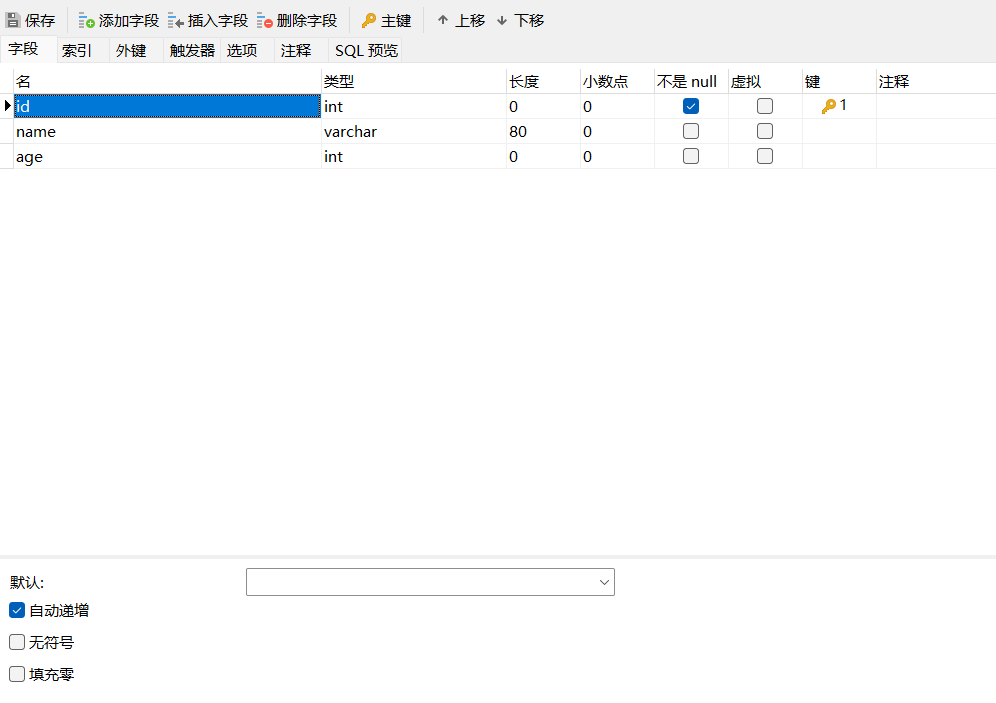
<?xml version="1.0" encoding="UTF-8"?><projectxmlns="http://maven.apache.org/POM/4.0.0"xmlns:xsi="http://www.w3.org/2001/XMLSchema-instance"xsi:schemaLocation="http://maven.apache.org/POM/4.0.0 http://maven.apache.org/xsd/maven-4.0.0.xsd"><modelVersion>4.0.0</modelVersion><groupId>org.example</groupId><artifactId>Spring-13</artifactId><version>1.0-SNAPSHOT</version><properties><project.build.sourceEncoding>UTF-8</project.build.sourceEncoding><maven.compiler.source>10</maven.compiler.source><maven.compiler.target>10</maven.compiler.target></properties><dependencies><dependency><groupId>junit</groupId><artifactId>junit</artifactId><version>4.13.2</version><scope>test</scope></dependency><dependency><groupId>org.springframework</groupId><artifactId>spring-aspects</artifactId><version>5.2.5.RELEASE</version></dependency><dependency><groupId>org.mybatis</groupId><artifactId>mybatis</artifactId><version>3.5.7</version></dependency><dependency><groupId>mysql</groupId><artifactId>mysql-connector-java</artifactId><version>8.0.26</version></dependency><!--spring事务依赖--><dependency><groupId>org.springframework</groupId><artifactId>spring-tx</artifactId><version>5.3.4</version></dependency><dependency><groupId>org.springframework</groupId><artifactId>spring-jdbc</artifactId><version>5.3.4</version></dependency><!--mybatis和spring集成依赖--><dependency><groupId>org.mybatis</groupId><artifactId>mybatis-spring</artifactId><version>1.3.3</version></dependency><!--阿里的连接池--><dependency><groupId>com.alibaba</groupId><artifactId>druid</artifactId><version>1.1.12</version></dependency></dependencies><build><resources><resource><directory>src/main/java</directory><includes><include>**/*.properties</include><include>**/*.xml</include></includes><filtering>false</filtering></resource></resources></build></project>
packagecom.lu.domain;publicclassStudent{privateInteger id;privateString name;privateInteger age;publicIntegergetId(){return id;}publicvoidsetId(Integer id){this.id = id;}publicStringgetName(){return name;}publicvoidsetName(String name){this.name = name;}publicIntegergetAge(){return age;}publicvoidsetAge(Integer age){this.age = age;}@OverridepublicStringtoString(){return"Student{"+"id="+ id +", name='"+ name +'\''+", age="+ age +'}';}}
packagecom.lu.dao;importcom.lu.domain.Student;importjava.util.List;publicinterfaceStudentDao{intinsertStudent(Student student);List<Student>selectStudents();}
<?xml version="1.0" encoding="UTF-8" ?><!DOCTYPEmapperPUBLIC"-//mybatis.org//DTD Mapper 3.0//EN""http://mybatis.org/dtd/mybatis-3-mapper.dtd"><mappernamespace="com.lu.dao.StudentDao"><!--使用insert,update,delete,select标签写sql--><insertid="insertStudent">
insert into student2(name,age) values(#{name},#{age})
</insert><selectid="selectStudents"resultType="com.lu.domain.Student">
select id,name,age from student2
</select></mapper>
<?xml version="1.0" encoding="UTF-8" ?><!DOCTYPEconfigurationPUBLIC"-//mybatis.org//DTD Config 3.0//EN""http://mybatis.org/dtd/mybatis-3-config.dtd"><configuration><settings><settingname="logImpl"value="STDOUT_LOGGING"/></settings><typeAliases><packagename="com.lu.domain"/></typeAliases><mappers><!--<mapper resource="com\lu\dao\StudentDao.xml"/>--><!--
要求:
1.mapper文件和dao接口在同一个目录
2.mapper文件和dao接口名称一致
--><packagename="com.lu.dao"/></mappers></configuration>
packagecom.lu.service;importcom.lu.domain.Student;importjava.util.List;publicinterfaceStudentService{intaddStudent(Student student);List<Student>queryStudent();}
packagecom.lu.service.impl;importcom.lu.dao.StudentDao;importcom.lu.domain.Student;importcom.lu.service.StudentService;importjava.util.List;publicclassStudentServiceImplimplementsStudentService{privateStudentDao studentDao;publicvoidsetStudentDao(StudentDao studentDao){this.studentDao = studentDao;}@OverridepublicintaddStudent(Student student){int rows = studentDao.insertStudent(student);return rows;}@OverridepublicList<Student>queryStudent(){List<Student> students = studentDao.selectStudents();return students;}}
<?xml version="1.0" encoding="UTF-8"?><beansxmlns="http://www.springframework.org/schema/beans"xmlns:xsi="http://www.w3.org/2001/XMLSchema-instance"xmlns:context="http://www.springframework.org/schema/context"xsi:schemaLocation="http://www.springframework.org/schema/beans http://www.springframework.org/schema/beans/spring-beans.xsd http://www.springframework.org/schema/context https://www.springframework.org/schema/context/spring-context.xsd"><!--加载外部的属性配置文件--><context:property-placeholderlocation="classpath:jdbc.properties"></context:property-placeholder><!--声明数据源DataSource--><beanid="dataSource"class="com.alibaba.druid.pool.DruidDataSource"init-method="init"destroy-method="close"><propertyname="url"value="${jdbc.url}"></property><propertyname="username"value="${jdbc.username}"></property><propertyname="password"value="${jdbc.passwprd}"></property></bean><!--声明SqlSessionFactoryBean,在这个类的内部,创建SqlSessionFactory--><beanid="factory"class="org.mybatis.spring.SqlSessionFactoryBean"><!--指定数据源--><propertyname="dataSource"ref="dataSource"></property><!--指定mybatis的主配置文件
Resource可以直接使用value属性
--><propertyname="configLocation"value="classpath:mybatis.xml"></property></bean><!--声明MapperScannerConfiguration
SqlSession.getMapper(StudentDao.class)
循环basePackage所表示的包,把包中的每个接口都找到,调用SqlSession.getMapper
把每个dao接口都创建出dao对象,dao代理对象放在容器中
ApplicationContext ctx = ....
SqlSessionFactory sqlSessionFactory = ctx.getBean("factory");
SqlSession session = sqlSessionFactory.openSession();
for(接口: com.lu.dao){
接口 对象 = session.getMapper(接口)
springMap.put(接口名的首字母小写,对象)
}
--><beanclass="org.mybatis.spring.mapper.MapperScannerConfigurer"><!--指定SqlSessionFactory对象的名称--><propertyname="sqlSessionFactoryBeanName"value="factory"></property><!--指定基本包,dao接口所在的包名--><propertyname="basePackage"value="com.lu.dao"></property></bean><!--声明service--><beanid="studentService"class="com.lu.service.impl.StudentServiceImpl"><propertyname="studentDao"ref="studentDao"></property></bean></beans>
packagecom.lu;importcom.lu.dao.StudentDao;importcom.lu.domain.Student;importcom.lu.service.StudentService;importorg.junit.Test;importorg.springframework.context.ApplicationContext;importorg.springframework.context.support.ClassPathXmlApplicationContext;importjava.util.List;publicclassMyTest{@Testpublicvoidtest01(){ApplicationContext ctx =newClassPathXmlApplicationContext("applicationContext.xml");StudentDao dao =(StudentDao) ctx.getBean("studentDao");Student student =newStudent();
student.setAge(21);
student.setName("张三");
dao.insertStudent(student);}@Testpublicvoidtest02(){String config ="applicationContext.xml";ApplicationContext ctx =newClassPathXmlApplicationContext(config);StudentService service =(StudentService) ctx.getBean("studentService");Student student =newStudent();
student.setAge(22);
student.setName("李四");
service.addStudent(student);}@Testpublicvoidtest03(){String config ="applicationContext.xml";ApplicationContext ctx =newClassPathXmlApplicationContext(config);StudentService service =(StudentService) ctx.getBean("studentService");List<Student> students = service.queryStudent();for(Student stu :
students){System.out.println(stu);}}}
5 Spring事务
5.1 事务的概念
什么是事务?事务时一些sql序列的集合,是多条sql,作为一个整体执行
mysql执行事务
beginTransaction 开启事务
insert into student() values...
select * from student where id = 1001
update school set name=xxx where id = 1005
endTransaction 事务结束
什么情况下需要使用事务?
一个操作需要多条(2条或2条以上的sql)sql语句一起完成,操作才能成功。
5.2 在程序中事务在哪说明
事务:放在业务类的方法上面(public方法上面),表示业务方法执行时,需要事务的支持
publicclassAccountService{privateAccountDao dao;privateMoneyDao dao2;//在service(业务类)的public方法上面,需要说明事务publicvoidtrans(String a,String b,Integer money){
dao.updateA();
dao.updateB();
dao2.insertA();}}publicclassAccountDao{publicvoidupdateA(){}publicvoidupdateB(){}}publicclassMoneyDao{publicvoidinsertA(){}publicvoiddeleteB(){}}
5.3 事务管理器
5.3.1 不同的数据库访问技术,处理事务是不同的
1)使用jdbc访问数据库,事务处理。
publicvoidupdateAccount(){Connection conn =...
conn.setAutoCommit(false);
stat.insert();
stat.update();
conn.commit();
conn.setAutoCommit(true);}
2)mybatis执行数据库,处理事务
publicvoidupdateAccount(){SqlSession session =Sqlsession.openSession(false);try{
session.insert("insert into student...");
session.update("update school....");
session.commit();}catch(Exception e){
session.rollback();}}
5.3.2 spring同意管理事务,把不同的数据库访问技术的事务处理统一起来
使用spring的事务管理器,管理不同的数据库访问技术的事务处理,开发人员只需要掌握spring的事务处理一个方案,就可以实现使用不同数据库访问技术的事务管理。
管理事务面向的是spring,有spring管理事务,做事务提交,事务回滚
5.3.3 Spring事务管理器
Spring框架使用事务管理器对象,管理所有的事务
事务管理器接口:PlatFormTransactionManager
作用:定义了事务的操作,主要是commit(),rollback()
事务管理器有很多实现类:一种数据库的访问技术有一个实现类。由实现类具体完成事务的提交,回滚。
意味着:jdbc或者mybatis访问数据库有自己的事务管理器实现类:DataSourceTransactionManager
hibernate框架,他的事务管理器实现类:HibernateTransactionManager
5.3.4 事务的提交和回滚的时机
什么时候提交事务,回滚事务?
当你的业务方法正常执行时,没有异常,事务是提交的。如果你的业务方法抛出运行时异常,事务是回滚的。
异常分类:
Error:严重错误。回滚事务
Exception:异常类,可以处理的异常情况
1)运行时异常:RuntimeException和它的子类都是运行时异常,在程序执行过程中抛出的异常。常见的运行时异常:NullPoinerException,NumberFormatException,IndexOutOfBoundException,ArithmeticException
2)受查异常:编写Java代码的时候,必须处理的异常。例如IOException,SQLException,FileNotFoundException
怎么记忆?
方法中抛出了运行时异常,事务回滚,其他情况(正常执行方法,受查异常)就是提交事务。
5.3.5 使用使用的AOP的环绕通知
环绕通知:可以在目标方法的前和后都能增强功能,不需要修改代码。
spring给业务方法在执行时,增加上事务的切面功能
@Around(value ="execution(* 所有业务类中的方法)")publicObjectmyAround(ProceedingJoinPoint pjp){try{PlatformTransactionManager.beginTransaction();//使用spring的事务管理器,开启事务
pjp.proceed();执行目标方法
PlatformTransactionManager.commit();//业务方法正常执行,提交事务}catch(Exception e){PlatformTransactionManager.rollback();//业务方法未正常执行,回滚事务}}
5.4 事务定义接口TransactionDefinition
TransactionDefinition接口。定义了三类常量,定义了有关事务控制的属性。
事务的属性:1) 隔离级别 2) 传播行为 3) 事务的超时
给业务方法说明事务属性。和ACID不一样。
5.4.1 隔离级别
隔离级别:控制事务之间影响的程度。
5个值,只有四个隔离级别
1)DEFAULT:采用DB默认的事务隔离级别。Mysql默认为REPEATABLE_READ;Oracle默认为READ_COMMITTED。
2)READ_UNCOMMITTED:读未提交。未解决任何并发问题
3)READ_COMMITTED:读已提交。解决脏读,存在不可重复读与幻读
4)REPEATABLE_READ:可重复读。解决脏读,不可重复读,存在幻读
5)SERIALIZABLE:串行化。不存在并发问题。
5.4.2 超时时间
超时时间,以秒为单位。整数值,默认是-1
超时时间:表示一个业务方法最长的执行时间,到达时间没有执行完毕,spring回滚事务。
5.4.3 传播行为
传播行为有7个值
传播行为:业务方法在调用时,事务在方法之间的,传递和使用。
使用传播行为,标识方法有无事务。
PROPAGATION_REQUIRED
PROPAGATION_REQUIRES_NEW
PROPAGATION_SUPPORTS
以上三个需要掌握
PROPAGATION_MANDATORY
PROPAGATION_NESTED
PROPAGATION_NEVER
PROPAGATION_NOT_SUPPORTED
1)REQUIRED:spring默认传播行为,方法在调用的时候,如果存在事务就是使用当前的事务,如果没有事务,则新建事务,方法在新事物中执行。
2)SUPPORTS:支持,方法有事务可以正常执行,没有事务也可以正常执行。
3)REQUIRES_NEW:方法需要一个新事物。如果调用方法时,存在一个事务,则原来的事务暂停,直到新事务执行完毕。如果方法调用时,没有事务,则新建一个事务,在新事务执行代码。
5.5 Spring框架使用自己的注解@Transactional控制事务
@Transactional注解,使用注解的属性控制事务(隔离级别,传播行为,超时)
属性:
1.propagation:事务的传播行为,它使用的Propagation类的枚举值,例如 Propagation.REQUIRED
2.isolation:表示隔离级别,使用isolation类的枚举值,表示隔离级别。默认 Isolation.DEFAULT
3.readOnly:boolean类型的值,表示数据库操作是不是只读的,默认是false
4.timeout:事务超时,默认是-1,整数值,单位是秒。例如timeout=20
5.rollbackFor:表示回滚的异常类列表,他的值是一个数组,每个值是异常类型的class
6.rollbackForClassName:表示回滚的异常类列表,他的值是异常类名称,是String类型的值
7.noRollbackFor:不需要回滚的异常类列表,是class类型的
8.noRollbackForClassName:不需要回滚的异常类列表,是String类型的值
位置:
1.在业务方法的上面,在public方法的上面
2.在类的上面
注解的使用步骤:
1.在spring的配置文件,声明事务的内容
声明事务管理器,说明使用哪个事务管理器对象
声明使用注解管理事务,开启事务注解驱动
2.在类的源代码中,加入@Transactional
事务的控制模式:1.编程式,在代码中变成控制事务。 2。声明式事务,不需要编码
例子:
spring配置文件
<?xml version="1.0" encoding="UTF-8"?><beansxmlns="http://www.springframework.org/schema/beans"xmlns:xsi="http://www.w3.org/2001/XMLSchema-instance"xmlns:context="http://www.springframework.org/schema/context"xmlns:tx="http://www.springframework.org/schema/tx"xsi:schemaLocation="http://www.springframework.org/schema/beans http://www.springframework.org/schema/beans/spring-beans.xsd http://www.springframework.org/schema/context https://www.springframework.org/schema/context/spring-context.xsd http://www.springframework.org/schema/tx http://www.springframework.org/schema/tx/spring-tx.xsd"><context:property-placeholderlocation="classpath:jdbc.properties"></context:property-placeholder><beanid="dataSource"class="com.alibaba.druid.pool.DruidDataSource"init-method="init"destroy-method="close"><propertyname="url"value="${jdbc.url}"></property><propertyname="username"value="${jdbc.username}"></property><propertyname="password"value="${jdbc.passwprd}"></property></bean><beanid="factory"class="org.mybatis.spring.SqlSessionFactoryBean"><propertyname="dataSource"ref="dataSource"></property><propertyname="configLocation"value="classpath:mybatis.xml"></property></bean><beanclass="org.mybatis.spring.mapper.MapperScannerConfigurer"><propertyname="sqlSessionFactoryBeanName"value="factory"></property><propertyname="basePackage"value="com.lu.dao"></property></bean><!--声明service--><beanid="buyService"class="com.lu.service.impl.BuyGppdsServoceImpl"><propertyname="goodsDao"ref="goodsDao"></property><propertyname="saleDao"ref="saleDao"></property></bean><!--声明事务的控制--><!--声明事务管理器--><beanid="transactionManager"class="org.springframework.jdbc.datasource.DataSourceTransactionManager"><!--指定数据源DataSource--><propertyname="dataSource"ref="dataSource"></property></bean><!--开启事务注解驱动,告诉框架使用注解管理驱动
transaction-manager:指定事务管理器的id
--><tx:annotation-driventransaction-manager="transactionManager"></tx:annotation-driven></beans>
java代码
packagecom.lu.service.impl;importcom.lu.dao.GoodsDao;importcom.lu.dao.SaleDao;importcom.lu.domain.Goods;importcom.lu.domain.Sale;importcom.lu.exception.NotEnougthException;importcom.lu.service.BuyGppdsServoce;importorg.springframework.transaction.annotation.Isolation;importorg.springframework.transaction.annotation.Propagation;importorg.springframework.transaction.annotation.Transactional;publicclassBuyGppdsServoceImplimplementsBuyGppdsServoce{privateSaleDao saleDao;privateGoodsDao goodsDao;publicvoidsetSaleDao(SaleDao saleDao){this.saleDao = saleDao;}publicvoidsetGoodsDao(GoodsDao goodsDao){this.goodsDao = goodsDao;}/*
第一种设置方式
@Transactional(
propagation = Propagation.REQUIRED,
isolation = Isolation.DEFAULT,
readOnly = false,
timeout = 20,
rollbackFor = {NullPointerException.class,NotEnougthException.class})
第二种设置方式
@Transactional(
propagation = Propagation.REQUIRED,
isolation = Isolation.DEFAULT,
readOnly = false,
timeout = 20)
解释rollbackFor的使用
1)框架首先检查方法抛出的异常是不是在rollbackFor的数组中,如果在一定回滚
2)如果方法抛出的异常不在rollbackFor数组,框架会继续检查抛出的异常是不是 运行时异常RuntimeException
如果是RuntimeException,一定回滚
第三种方式:使用默认值 REQUIRED,发生运行时异常回滚
*
*/@Transactional(
propagation =Propagation.REQUIRED,
isolation =Isolation.DEFAULT,
readOnly =false,
timeout =20,
rollbackFor ={NullPointerException.class,NotEnougthException.class})@Overridepublicvoidbuy(Integer goodsId,Integer num){System.out.println("buy方法的开始。。。。。。。。。。");//生成销售记录Sale sale =newSale();
sale.setGid(goodsId);
sale.setNum(num);
saleDao.insertSale(sale);//查询商品Goods goods = goodsDao.selectById(goodsId);if(goods ==null){thrownewNullPointerException(goodsId +"商品不存在");}elseif(goods.getAmount()< num){thrownewNotEnougthException(goodsId +"库存不足");}//更新库存Goods buyGoods =newGoods();
buyGoods.setId(goodsId);
buyGoods.setAmount(num);
goodsDao.updateGoods(buyGoods);System.out.println("buy方法的结束。。。。。。。。。。");}}
@Transactional使用的特点:
1.spring框架自己提供的事务控制
2.适合中小型项目
3.使用方便,效率高
5.6 使用Aspectj框架在spring配置文件中,声明事务控制
使用aspectj的aop,声明事务控制叫做声明式事务
使用步骤:
- pom.xml加入spring-aspects的依赖
- 在spring的配置文件声明事务的内容1)声明事务管理器2)声明业务方法需要的事务属性3)声明切入点表达式
声明式事务:
spring配置文件
<?xml version="1.0" encoding="UTF-8"?><beansxmlns="http://www.springframework.org/schema/beans"xmlns:xsi="http://www.w3.org/2001/XMLSchema-instance"xmlns:context="http://www.springframework.org/schema/context"xmlns:tx="http://www.springframework.org/schema/tx"xmlns:aop="http://www.springframework.org/schema/aop"xsi:schemaLocation="http://www.springframework.org/schema/beans http://www.springframework.org/schema/beans/spring-beans.xsd http://www.springframework.org/schema/context https://www.springframework.org/schema/context/spring-context.xsd http://www.springframework.org/schema/tx http://www.springframework.org/schema/tx/spring-tx.xsd http://www.springframework.org/schema/aop https://www.springframework.org/schema/aop/spring-aop.xsd"><context:property-placeholderlocation="classpath:jdbc.properties"></context:property-placeholder><beanid="dataSource"class="com.alibaba.druid.pool.DruidDataSource"init-method="init"destroy-method="close"><propertyname="url"value="${jdbc.url}"></property><propertyname="username"value="${jdbc.username}"></property><propertyname="password"value="${jdbc.passwprd}"></property></bean><beanid="factory"class="org.mybatis.spring.SqlSessionFactoryBean"><propertyname="dataSource"ref="dataSource"></property><propertyname="configLocation"value="classpath:mybatis.xml"></property></bean><beanclass="org.mybatis.spring.mapper.MapperScannerConfigurer"><propertyname="sqlSessionFactoryBeanName"value="factory"></property><propertyname="basePackage"value="com.lu.dao"></property></bean><!--声明service--><beanid="buyService"class="com.lu.service.impl.BuyGppdsServoceImpl"><propertyname="goodsDao"ref="goodsDao"></property><propertyname="saleDao"ref="saleDao"></property></bean><!--声明式事务:不用写代码--><!--1.声明事务管理器--><beanid="transactionManager"class="org.springframework.jdbc.datasource.DataSourceTransactionManager"><propertyname="dataSource"ref="dataSource"></property></bean><!--2.声明业务方法的事务属性 (隔离级别,传播行为,超时)
id:给业务方法配置事务段代码七个名称,为一只
transaction-manager:事务管理器的id
--><tx:adviceid="serviceAdvice"transaction-manager="transactionManager"><!--给具体的业务方法增加事务的说明--><tx:attributes><!--
给具体的业务方法,说明他需要的事务属性
name:业务方法的名称。
配置name的值:1.业务方法的名称 2.带有部分通配符的方法名称 3.使用*
propagation:指定传播行为的值
isolation:隔离级别
read-only:是否只读,默认是false
timeout:超时时间
rollback-for:指定回滚的异常类列表,使用的异常全限定名称
--><tx:methodname="buy"propagation="REQUIRED"isolation="DEFAULT"read-only="false"timeout="20"rollback-for="java.lang.NullPointerException,com.lu.exception.NotEnougthException"/></tx:attributes></tx:advice><!--声明切入点表达式:表示哪些包中的类,类中的方法参与事务--><aop:config><!--
声明切入点表达式
expression:切入点表达式,表示哪些类和类中的方法要参与事务
id:切入点表达式的名称,唯一值
expression怎么写?
--><aop:pointcutid="servicePointcut"expression="execution(* *..service..*.*(..))"/><!--关联切入点表达式和事务通知--><aop:advisoradvice-ref="serviceAdvice"pointcut-ref="servicePointcut"></aop:advisor></aop:config></beans>
声明式事务优缺点:
缺点:
- 理解难,配置复杂。
有点:
- 代码和事务配置是分开的,控制事务源代码不用修改
- 能快速的了解和掌控项目的全部事务。适合大型项目 中,声明事务控制
使用aspectj的aop,声明事务控制叫做声明式事务
使用步骤:
- pom.xml加入spring-aspects的依赖
- 在spring的配置文件声明事务的内容1)声明事务管理器2)声明业务方法需要的事务属性3)声明切入点表达式
声明式事务:
spring配置文件
<?xml version="1.0" encoding="UTF-8"?><beansxmlns="http://www.springframework.org/schema/beans"xmlns:xsi="http://www.w3.org/2001/XMLSchema-instance"xmlns:context="http://www.springframework.org/schema/context"xmlns:tx="http://www.springframework.org/schema/tx"xmlns:aop="http://www.springframework.org/schema/aop"xsi:schemaLocation="http://www.springframework.org/schema/beans http://www.springframework.org/schema/beans/spring-beans.xsd http://www.springframework.org/schema/context https://www.springframework.org/schema/context/spring-context.xsd http://www.springframework.org/schema/tx http://www.springframework.org/schema/tx/spring-tx.xsd http://www.springframework.org/schema/aop https://www.springframework.org/schema/aop/spring-aop.xsd"><context:property-placeholderlocation="classpath:jdbc.properties"></context:property-placeholder><beanid="dataSource"class="com.alibaba.druid.pool.DruidDataSource"init-method="init"destroy-method="close"><propertyname="url"value="${jdbc.url}"></property><propertyname="username"value="${jdbc.username}"></property><propertyname="password"value="${jdbc.passwprd}"></property></bean><beanid="factory"class="org.mybatis.spring.SqlSessionFactoryBean"><propertyname="dataSource"ref="dataSource"></property><propertyname="configLocation"value="classpath:mybatis.xml"></property></bean><beanclass="org.mybatis.spring.mapper.MapperScannerConfigurer"><propertyname="sqlSessionFactoryBeanName"value="factory"></property><propertyname="basePackage"value="com.lu.dao"></property></bean><!--声明service--><beanid="buyService"class="com.lu.service.impl.BuyGppdsServoceImpl"><propertyname="goodsDao"ref="goodsDao"></property><propertyname="saleDao"ref="saleDao"></property></bean><!--声明式事务:不用写代码--><!--1.声明事务管理器--><beanid="transactionManager"class="org.springframework.jdbc.datasource.DataSourceTransactionManager"><propertyname="dataSource"ref="dataSource"></property></bean><!--2.声明业务方法的事务属性 (隔离级别,传播行为,超时)
id:给业务方法配置事务段代码七个名称,为一只
transaction-manager:事务管理器的id
--><tx:adviceid="serviceAdvice"transaction-manager="transactionManager"><!--给具体的业务方法增加事务的说明--><tx:attributes><!--
给具体的业务方法,说明他需要的事务属性
name:业务方法的名称。
配置name的值:1.业务方法的名称 2.带有部分通配符的方法名称 3.使用*
propagation:指定传播行为的值
isolation:隔离级别
read-only:是否只读,默认是false
timeout:超时时间
rollback-for:指定回滚的异常类列表,使用的异常全限定名称
--><tx:methodname="buy"propagation="REQUIRED"isolation="DEFAULT"read-only="false"timeout="20"rollback-for="java.lang.NullPointerException,com.lu.exception.NotEnougthException"/></tx:attributes></tx:advice><!--声明切入点表达式:表示哪些包中的类,类中的方法参与事务--><aop:config><!--
声明切入点表达式
expression:切入点表达式,表示哪些类和类中的方法要参与事务
id:切入点表达式的名称,唯一值
expression怎么写?
--><aop:pointcutid="servicePointcut"expression="execution(* *..service..*.*(..))"/><!--关联切入点表达式和事务通知--><aop:advisoradvice-ref="serviceAdvice"pointcut-ref="servicePointcut"></aop:advisor></aop:config></beans>
声明式事务优缺点:
缺点:
- 理解难,配置复杂。
有点:
- 代码和事务配置是分开的,控制事务源代码不用修改
- 能快速的了解和掌控项目的全部事务。适合大型项目
版权归原作者 毕业势必进大厂 所有, 如有侵权,请联系我们删除。